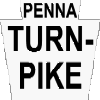
Pennsylvania Turnpike

Pennsylvania
Turnpike
Referred to as "America's First Superhighway," it is strange to think that the Turnpike had its roots in another form of transportation: the railroad. William H. Vanderbilt proposed an idea to build a railroad from Harrisburg to Pittsburgh that would be under his control, and not that of the Pennsylvania Railroad.
After the surveying was complete, work began on a two-track roadbed with nine tunnels. Excavation began on the tunnels in early 1884. Thousands of workers dug the tunnels for $1.25 for a 10 hour day. The construction continued through 1884 and 1885; however, trouble for the project was starting in New York. Banker J. Pierpont Morgan won a seat on the board of Vanderbilt's New York City & Hudson River Railroad. Morgan with the President of the NYC&HRRR sold the right-of-way to George B. Roberts, President of the Pennsylvania Railroad. Work stopped immediately. A total of $10 million had been spent and 26 workers lost their lives. The unfinished project came to be known as "Vanderbilt's Folly."
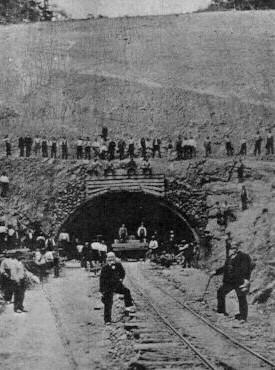
Andrew Carnegie visits the Rays
Hill Tunnel work site.
(Pennsylvania State Archives)
A part of the right-of-way was used for the Pittsburgh, Westmoreland, and Somerset short line railroad. The PW&S even completed one of the nine tunnels. None of the other tunnels had been finished, but some workers say that some were close enough to hear crews in the other section. Most of the line reverted to nature with water filling many of the tunnels. One of the engineers said this on the demise of the line: "And here, for the time being, and probably for a long time to come, is smothered the best line of railroad between the Ohio Valley and the Atlantic that has ever been or can be projected, built, or operated."
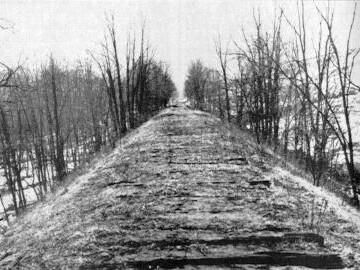
Some of the graded roadbed utilized by
a short line
railroad near Somerset in 1885.
(Pennsylvania State Archives)
Links:
South Penn Railroad Right of
Way
Pittsburgh, Westmoreland, &
Somerset Railroad and South Penn Railroad Grade - Russell Love
The twentieth century came and with it a new form of transportation: the automobile. Pennsylvania was one of the first states to establish a highway department. In late 1934, an employee with the State Planning Board named Victor Lecoq and William Sutherland of the Pennsylvania Motor Truck Association proposed the idea of building a toll highway utilizing the old roadbed and tunnels left behind. With these two gentlemen and with newly elected Representative Cliff S. Patterson, the idea became reality. On April 23, 1935, he introduced House Resolution # 138 to authorize a feasibility study.
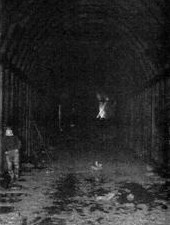
Preliminary work inside
the Tuscarora Mountain
Tunnel on January 24, 1938.
(Pennsylvania State Archives)
Construction was proposed to cost anywhere from $60 million to $70 million. The surveyor's report was favorable and upon receiving this news, Governor George Earle signed Act 211 on May 21, 1937. This legislation enacted the Pennsylvania Turnpike Commission. On June 4, the initial commission members were named.
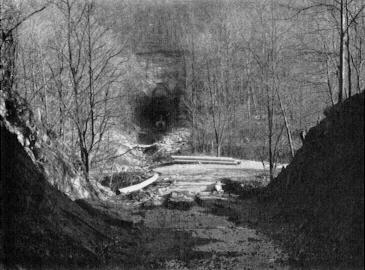
The valley between the Blue and Kittatinny
Mountains as it appeared on November 5, 1937.
(Pennsylvania State Archives)
Although financing had yet to be completed, the first contract to be awarded was to Pittsburgh contractor George Vang. This was for removal of the water from the existing tunnels. The final federal approval for financing came on October 10, 1938. Four days later, the first contract for construction of the highway was advertised for bids. The contract, which covered a 10 mile stretch in Cumberland County, was awarded to the L.M. Hutchison Company of Mount Union, Pennsylvania. The problem was that there was not a single stretch of right-of-way purchased. That problem was resolved when the Turnpike's General Counsel, John D. Faller, traveled to Cumberland County to talk to the farmer whose land was proposed as the future right-of-way. Mr. Faller, and the representatives from the Public Works Administration and the Reconstruction Finance Corporation, came to the site were the ground breaking would take place. There were 200-300 farmers and neighbors standing around. The gentlemen spoke to the wife of the farmer who owned the land. She agreed to sell the tract to the state. Afterwards she wanted their autographs. When Mr. Jones asked why, she said: "Mr. Jones, I want these autographs so that my children can say that they saw history being made that day when the greatest highway, a new era of road building, was started."
|
|
|
|
Until the first shovels of dirt were thrown, the PTC relied on funds from the federal government, the Department of Highways, and loans from engineers from private industry. At first, Chief Engineer Samuel W. Marshall supervised 115 engineers, but within three months that number grew to more than 1,100. The added staff was necessary for the Commission to meet the construction-season cycle and the deadline for completion set by the federal government. The planners figured on a three-four year construction period, but in the approval of the $29 million grant, the Public Works Administration set a completion date of May 1, 1940 (moved to June by a later amendment), by which the highway should be "substantially complete." This meant the PTC had a short 20 month deadline to by which to complete a large public works project.
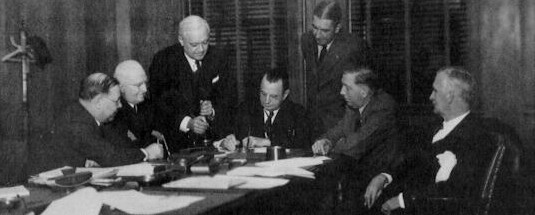
Commission officials meet on October 10, 1938. From left to right:
Commission nominee Edward N. Jones, Commissioner Frank Bebout,
Chief Counsel John Faller, Commission Chairman Walter A. Jones,
Chief Engineer Samuel Marshall, Secretary of Highways Roy Brownmiller,
and Commissioner Charles Carpenter.
The engineers also had to change
they way they designed highways. Highways had always been built with
flat curves to discourage speeding. Now, the engineers were expected
to design easy grades, to allow cars and trucks year round use. Long,
sweeping curves would give ample room for high speeds and safe stopping
distances. The engineers decided on the following
standards:
What separated this highway from others was that it was considered one continuous design task from Irwin to Carlisle. Charles Noble, a design engineer for the Commission who later moved on to become chief engineer for the New Jersey Highway Department and the New Jersey Turnpike Authority, described this feat in the July 1940 Civil Engineering magazine, "Unlike the existing highway systems of the United States, in which design standards fluctuate every few miles, depending on the date of construction, the Turnpike will have the same design characteristics throughout its 160-mile length. Every effort has been directed towards securing uniform and consistent operating conditions for the motorist." He also went on to say, "In fact, the design was attacked from the viewpoint of motor-car operation and the human frailty of the driver, rather than from that of the difficulty of the terrain and method of construction This policy of design, based on vehicle operation, is relatively new."
Even with the construction getting underway, there was already a place in the United States where people could experience a long-distance superhighway: General Motor's "Futurama" exhibit at the 1939-40 World's Fair in New York City. Sixteen million visitors took a 16 minute narrated ride through a vision of the United States in the far off year of 1960. Norman Bel Geddes, an industrial designer, built a diorama that had as its focus limited-access superhighways. People were able to get a taste of the things to come. However, many of the principles that were showcased in the exhibit, and used in the Turnpike's design, were already a part of Germany's Autobahns and on a 15-mile section of the Bronx River Parkway in New York City.
As the proposed completion date
drew near, there was one problem the state was facing: no right-of-way
clearing nor excavation had taken place. This doesn't mean that
no work had taken place; however, workers had been busying pumping water
from the abandoned South Pennsylvania Railroad tunnels so that engineers
could determine their condition. That changed when the Commission awarded
Contract Number 1 to the L. M. Hutchinson. After this happened, the
PTC began doing business with owners of 730 properties that lay in the path
of the Turnpike. Houses, farms, and at least one coal mine was acquired
by the state under eminent domain, which Pennsylvania was one of the few
states that then allowed an agency to take land from the holder without coming
to a deal with them, by posting a bond with a court, and agreeing to negotiate
a settlement later. Without this power, the project could not have
been finished as soon as it was.
With all of the preliminary work such as surveying and land acquisition completed, it was time to get down to business. Workers began to pour into the southern tier of Pennsylvania, almost 54 years after they did the same thing for the construction of Vanderbilt's railroad. One of the contractors held the distinction of working on both projects, and one man was documented as having worked on both the South Pennsylvania and Pennsylvania Turnpike projects.
Initially, a headquarters for the project staff was set up at the Department of Highway's district office in Hollidaysburg, then field offices in Shippensburg, Everett, Somerset, and Mount Pleasant.
By July 1939, the highway, seven tunnels, and more than 300 structures were under contract, and a month later construction was underway. The contracts were awarded to 155 companies from 18 states. The date that will go down in history as when concrete was first poured on a superhighway project is August 31, 1939. By the spring of 1940, 15,000 workers were helping to shape the future of highway construction. With all of these people coming en masse, housing was placed at a minimal in rural southwestern and south central Pennsylvania. It was so scarce that some employees lived, with their families, in tents near the construction sites. The hourly wages for the workers ranged from 52.5 cents for unskilled laborers to $1.40 for heavy equipment operators, compared to Vanderbilt's pay of $1.25 back in the 1880s.
With the work being hurried along at a fast pace to keep within the timetable, contractors had to work day and night with an average of two shifts a day and sometimes three. Portable generators supplied electricity for the work areas in the remote Pennsylvania woodlands, because little commercial electricity was available. Resident engineers and inspectors manned each site around the clock to insure that the work was able to progress. Approximately $30 million worth of then modern highway building equipment was utilized.
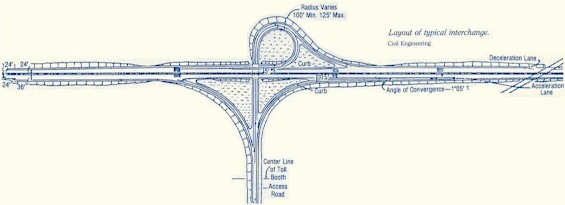
Typical interchange layout (Civil Engineering)
The project called
for:
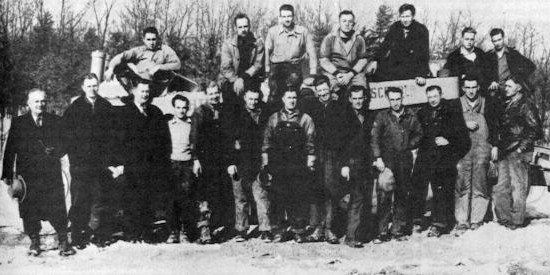
Crew of the L.M. Hutchison Company, the first contractor on the Turnpike.
(Pennsylvania State Archives)
The completion of the tunnels was the most daunting task of the project. None of the existing South Pennsylvania tunnels that were going to be used for the Turnpike were "holed-through" in 1885; however, they were excavated from both ends. The uncompleted sections ranged from 551 feet in the Kittatinny Mountain Tunnel to 3,379 feet in the Sideling Hill Tunnel. Problems also occurred due to the way that they were initially bored. The railroad's intent was to build double-track tunnels for its double-track line, but as corporate commitments and cash began to slow to a trickle, the design changed so that the tunnels would be only single-track width. Therefore, Turnpike engineers found wide entrances but narrow widths in the deepest parts. However, by utilizing the South Pennsylvania tunnels, a Turnpike engineer of that day estimated that it saved $2 million.
The construction occurred in a round-the-clock cycle, with the contractors working like an assembly-line. One group of workers would would drill about 100 holes 10 feet into rock, and then placed 800 to 1,100 pounds of explosives into the holes. After the detonation, a following shift would clear the rock and rubble. Softer rock required less holes, explosives, and drilling time. Work on the tunnels would average from 11.3 feet to 35.7 feet depending on the type of rock. In addition to widening the tunnels to a width of 23 feet, and a height of 14 feet, the contractors reinforced the walls and floors with concrete lining, and constructed buildings housing the ventilating fans which would blow fresh air into the tunnels and keep carbon monoxide levels safe for motorists. Many of the workers excavating the tunnels where coal miners idled due to a strike against the coal companies by labor leader John L. Lewis.
A problem developed in the Kittatinny Tunnel when workers struck a watery seam of sand, which released 500 to 1,000 cubic yards of red, green, and black sand into the tunnel. It not only required a massive cleanup and resulted in a delay, but also a redesign of the tunnel walls for that section. One accident occurred in the building of the tunnels, when at the Laurel Hill Tunnel site, four men died in a cave-in.
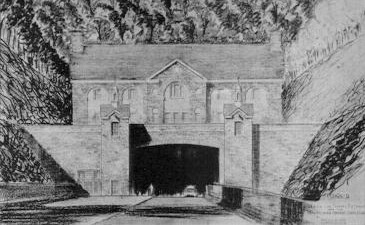
Early proposal for the tunnel entrances.
(Pennsylvania State Archives)
Another massive earth moving operation occurred just east of Everett at a hillside called Clear Ridge, where a tunnel was considered, but instead a large cut was employed. The cut carved is 153-feet-deep and a one-half-mile-long, and at the time, no highway cut that deep had ever been attempted in the United States. Promoters of the highway were quick to name the cut "Little Panama" to trade on the fame of the famous canal built in 1914. One difference between the two was the amount of dirt removed: only 1.1 million cubic yards at Clear Ridge compared to the 200 million cubic yards during the canal construction. The ridge is now known as either the Clear Ridge Cut or the N. R. Corbisello, the contractor from Binghamton, New York whose company performed the construction.
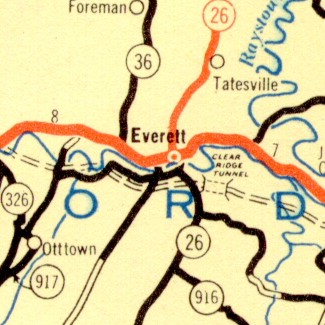
To smooth out the alignment where the terrain was uneven, fill was added and each time compacted to avoid any shifting that could occur when the concrete was poured. Approximately 13 miles of highway was poured in 1939, but wet weather hampered work in spring 1940. By May 8, 1940, only 30 miles of highway had been laid; however, soon 50 paving units would be producing two to three and one-half miles of highway a day.
|
|
Construction on the bridges and culverts would be a daunting task. 307 of them were designed and built, ranging in the the neighborhood of six feet to 600 feet in length. Twenty-one early overpasses were built with two spans that rested on a support column in the median strip, but federal officials balked at that plan saying it would pose a potential collision hazard. This resulted in most local highways passing over the Turnpike on single-span bridges, many with a gently arched concrete design. Three of the bridges won design awards: the largest bridge, a concrete viaduct east of New Stanton, the Dunnings Creek bridge near Bedford, and the Fort Littleton Interchange overpass. Also, a channel of the Juniata River was altered as part of the project.
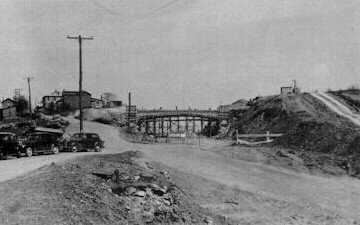
Single-span bridge over Turnpike near Donegal.
(Pennsylvania Turnpike Commission)
As spring turned into summer, the pieces of the puzzle were starting to fit. While the remainder of the work was drawing to a close, officials made test drives over the new highway sometimes at speeds of 100 MPH or more. Local motorists sneaked onto the Turnpike for their own personal test drive, a practice that was partially discouraged. Other preparations were underway such as law enforcement of the Turnpike. The Commission wanted its own force; however, Attorney General Claude T. Reno ruled that the then Pennsylvania Motor Police held jurisdiction. With that decision, a corp of 59 troopers was organized and trained at the state police academy at Hershey to specifically patrol the highway, with the cost of enforcement being paid from toll revenue. This branch is now known as Troop T.
With all the excitement building to the opening of America's first superhighway, one organization who would benefit from the opening was voicing concern over the toll rates. The Pennsylvania Motor Truck Association and its national affiliate the American Trucking Associations, negotiated with PTC officials on reducing round-trip fares for trucks, such as those offered to motorists, and reduced rates for high-volume users. The same this was going on, its newsletter Penntrux was carrying ads from Turnpike contractors seeking services such as leasing 45 dump trucks for paving jobs and trucks to haul Westinghouse transformers from rail sidings to the tunnels. Still, PMTA officials were pressing for rates to be cut in time for the highway's ribbon cutting.
A Fourth of July opening was scheduled, and President Franklin D. Roosevelt was reported to be the one who would cut the ribbon. However, Independence Day came and went with no opening ceremonies, postponed due to weather. On August 6, 1940, an impressive military convoy comprised of the National Guard's 108th Field Artillery battalion, made a 135 mile trip from Indiantown Gap military reservation north of Harrisburg to Bedford utilizing 85 miles of the still-incomplete Turnpike. The training exercise to prevent the "capture" of a theoretically "under siege" Bedford took eight hours and 15 minutes. This was partially from equipment breakdowns and partially from an eight mile detour around the Blue and Kittatinny Mountain Tunnels due to work still going on in that area.
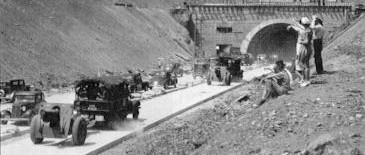
National Guard maneuvers over the Turnpike on
August 6, 1940. (Pennsylvania Turnpike Commission)
Later in the month of August, Walter Jones, commissioner of the PTC, organized a two-day motorcade for 175 guests, including US congressmen and senators from as far away as California. The tour began in Harrisburg on August 25 and the caravan began heading westward at 10:30 AM the next morning. The group stopped along the way to inspect toll booths, tunnels, ventilation fans, the Clear Ridge Cut, and for lunch at 1 PM at the Midway service plaza, while the Bedford Springs Orchestra performed. Jones, unable to attend due to illness, telephoned the group from Washington when its members arrived in Pittsburgh for a banquet at the Duquesne Club.
With no dedication still decided upon, bondholders began getting anxious. Many of them started to point out that each day the highway was not in operation, was another day its debt would not be closer to retirement. At least a half dozen dedication dates had been proposed and eventually scrapped. Some newspapers began to suspect politics were at fault since 1940 was a presidential election year. Whether it was partisan politics at force or not, it was true that scores of public officials of both parties rallied against Roosevelt's controversial campaign for a third term.
Of all of the work taking place in the days leading up to the opening, one thing still had not been worked out: toll rates. On September 11, the Commission approved the first fare schedule which was approximately $.01/mile for automobiles, or $1.50 for the 160 mile trip from end to end, and $2.50 round-trip. Tolls for trucks were based on weight and vehicle class, which was the result of the toll collector's inspection of tire size, ranging from $3 to $10. PMTA unhappy with the toll rates, urged its members to boycott the Turnpike.
The commissioners gathered again, with Jones in attendance, on Monday, September 30. It was that afternoon that he announced that the Turnpike would open for business at a minute past midnight Tuesday morning. With no ribbon-cutting, no ceremony, and no Roosevelt, the highway of tomorrow would be here today.
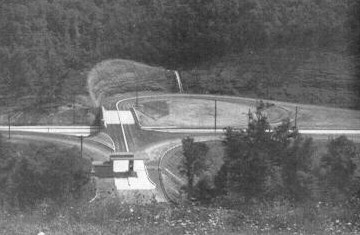
Fort Littleton Interchange before its opening.
(Pennsylvania Turnpike Commission)
Even though Walter Jones gave less than 12 hours notice that America's first superhighway would open, word began to spread quickly. The news of the grand opening spread from radio station reports that were broadcast throughout the afternoon, and by 6 PM motorists began lining up at toll booths to become the first or one of the first to travel the futuristic highway.
As soon as word got out, travelers and truckers alike altered their plans, with some making special trips from as far away as New York and West Virginia to ride the Turnpike. A family drove 150 miles out of their way, and still managed to get fourth place in line at the western terminus in Irwin. While all the excitement of the opening was going on, the first 50 attendants got prepared to do their job. Later Lee Rishel, superintendent of fare collection, recalled that the order for their uniforms hadn't arrived in time for the opening. So the only official looking clothing they wore was a uniform hat.
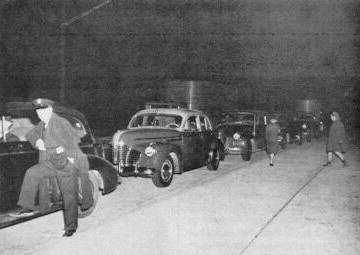
Motorists line up at Irwin, waiting for midnight.
(Pennsylvania Turnpike Commission)
Even before the official word came down, it had been speculated that the opening was nearing. A watchman at the Carlisle Interchange had to turn away some 600 motorists from 6 AM to 2 PM on September 30, the day the official announcement was made. Reports circulated about what people were doing to become the first on the highway. One man had waited four days at the Somerset Interchange, a Philadelphia-bound trucker since Sunday morning, and a ballet troupe from Boston heading to Oklahoma had been waiting at the New Stanton Interchange since early that Monday morning.
As the hours up to the grand opening lingered, some motorists slept to pass the time. A couple from Virginia had claimed first in line at Irwin, but after five hours had passed, decided to leave to get something to eat. When they came back, they found two cars had taken first and second place. In the final hours leading up to midnight, motorists at Irwin and New Stanton tried to buy tickets early, but were denied by the good-natured attendants.
As midnight drew nearer, the excitement of the crowds that had gathered at each entrance became heightened. The night added to the drama of the opening, with the shiny blue toll booths gleaming in the light from floodlights, which made a reporter from the Pittsburgh Sun-Telegraph comment that they were "lighted like the entrance to a beautiful exposition."
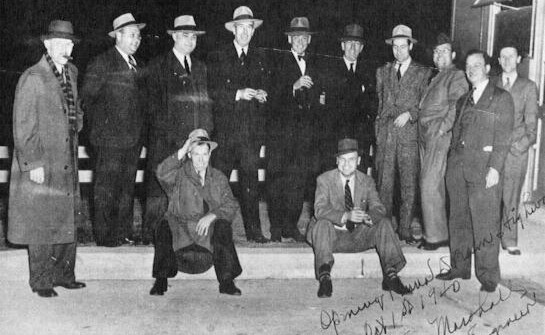
Turnpike's chief engineer, fifth from right, autographed this photo:
"Opening Pennsylvania Dream Highway, Oct. 1st, 1940,
Sam Marshall, Chief Engineer." (Pennsylvania Turnpike Commission)
Finally, the moment people were waiting for had finally come.
Attendants waved the lines of vehicles forward, began stamping, and handing out the first yellow toll tickets. However, before the motorists could head down into the history books, local officials congratulated them and reporters interviewed them. The scene at the western terminus in Irwin resembled a New Year's celebration with drivers honking their horns and cheering.
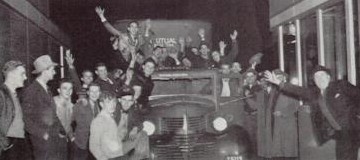
Spectators and well-wishers upon the opening
at the Irwin Interchange.
(Pennsylvania Turnpike Commission)
At the other end of the highway, where more than 100 people and 40 vehicles had gathered, the scene was the same. The Harrisburg Telegraph captured the event: "At midnight, two black cats ambled across the gleaming cement. A minute later, a ticket-seller dropped his arm in the gesture of an automobile race-starter, and traffic was under way." The first traveler to pass through the Carlisle booths was Homer D. Romberger, a feed and tallow dealer from Carlisle, who traveled 47 miles to Fort Littleton. Mr. Romberger happened to be one of the many who came to the ground breaking ceremonies on the Eberly farm just 23 months earlier. He was handed a ticket by R. H. Pastorius of Hummelstown, one of four on duty. Other Turnpike firsts occurred at Carlisle: the first out-of-state traveler, Bruce Carroll, on a journey back to his home in Ohio, the the first commercial vehicle on an interstate journey bound for Steubenville, Ohio, and the first heavy truck loaded with potatoes (symbolic of Pennsylvania's agricultural heritage) all entered at that toll plaza. In total, 20 cars and four trucks passed thru the plaza at Carlisle in the first hour of operation.
Back at the Irwin Interchange, the first driver to pass through the Irwin toll plaza was Carl A. Boe of McKeesport. He received his ticket from Morris Neilberg of Pittsburgh, one of three attendants on duty. Just after getting his toll ticket, he was waived down by two men from Greensburg: Frank Lorey and Dick Gangle. They were aiming to be, and were, the first hitchhikers on the Turnpike; a practice later banned by law. A father from Pittsburgh with his school-aged son and daughter, Michael and Mary Costello, made an overnight round-trip for the fun of it. Their father said as they waited in line at Irwin, "We filled the tank with gas and the car full of sandwiches. I promised to have the kids back in time for school tomorrow."
With the excitement dying down, the crowds going home, and the night lingering, the first drivers on each end began reaching the opposite side of the Turnpike. When they finally reached the other side, they told stories of traveling 80 and sometimes 90 MPH, while not having to worry about cross-traffic.
Speaking of the high speeds being achieved on the new Turnpike, it happened to be a distinctive feature that there was no set speed limit. In July 1940, a test car managed to do 102 MPH and then Governor Arthur James agreed that the normal statewide limit of 50 MPH would not apply. However, the attorney general convinced the governor that it would be in the best interest of the state if there was a speed limit on the Turnpike, and a week before the highway opened, it was announced that a 50 MPH limit would be imposed. The decree was flatly ignored by both motorists and the troopers patrolling the highway. People entering the highway who asked the attendants what the limit was, their response was simply "Drive carefully." It soon became apparent that the only limitations were nerve and common sense. An Ohio trucker who expected to get a speeding ticket told this story: "I was going down one of those grades at 70 to 80 miles an hour. I looked in the mirror and saw a white car following me. I didn't know whether I was going to get arrested, so I pulled off the road as though to take a rest. The white car pulled off, too. An officer got out and asked me, 'How do you like the road?' I said, 'It's very nice - I guess I get a ticket.' The cop told me, 'No, we aren't interested in the speed limit. As long as you stay on your own side and watch yourself, we won't bother you.'" If only that kind of attitude still prevailed.
One motorist who arrived in the early morning at the Carlisle toll plaza, reported that he traveled the entire 160 miles in two hours and ten minutes, an average of 74 MPH. Others who took longer, from anywhere between 2 hours 30 minutes to 2 hours 40 minutes, still managed to beat the usual time to travel between Harrisburg and Pittsburgh of five and one-half hours via the two-lane Lincoln (US 30) or William Penn (US 22) Highways. It turned out that the new toll highway was not only a faster and easier ride that these two highways, but also shorter: by about five miles compared to US 30 and about 18 miles compared to US 22. A driver managed to cover the 78 and one-half miles from Bedford to Carlisle in only 52 minutes, with an average speed of 91 MPH.
Traveling the highway at high speeds wasn't the only time saving way to accomplish the distance, but even at moderate speeds the highway would still save time. One trucker commented that he was able to cover in four hours what it normally would take ten, saving six hours and 20 gallons of gasoline. With all the time savings being discussed, there was still one complaint with the Turnpike: it didn't go on to Pittsburgh. Merle Foust, who was traveling from Somerset to Irwin, said, "It just ends where it should be starting."
Some travelers got so excited about the experience to driving the Turnpike, that they forgot to keep an eye on the fuel gauge. An attendant at the Carlisle (now Plainfield) Service Plaza reported that four cars had run out of gas, and he helped one of the drivers to push his car to the pumps. And some travelers did not want to partake of the the joy of driving the highway. A motorist from New York threatened to sue the PTC over the dime fare he was charged when he unwittingly entered the Turnpike. He got on at the Middlesex ramps and tried to make a U-turn two miles later at the Carlisle toll plaza. Even though he protested that the highway was not sufficiently signed, a state trooper ordered him to pay the dime toll and leave via the Carlisle ramp. On the topic of out of state travelers, it was noted that about half of the vehicles using the Turnpike on the first day of operation were from outside of Pennsylvania. And from those, about half of the states in the country were represented.
As the first day of operation came to an end, it was reported that 1,550 vehicles had entered the Turnpike at Irwin, and more than 1,900 at Carlisle. The log at the Bedford headquarters of the Pennsylvania Motor Police Turnpike Division noted: "No accidents, no arrests, and no unpleasantness."
Soon after the opening, Pennsylvania Greyhound Lines reported that it would begin long-haul intercity bus routes over the new highway. Prior to the Turnpike, it would take close to 9 hours to travel between Harrisburg and Pittsburgh utilizing US 22. Now the company was offering twice a day service taking only five and one-quarter hours which included a rest stop at Bedford. The Motor Bus Society reports that Greyhound was the first commercial account for the Turnpike. The Public Utility Commission, the agency responsible for regulating railroad and highway transportation commerce, granted the company intrastate rights to use the Turnpike with stops at Bedford and Somerset. The provision is that this new service did not have a negative impact on its existing routes. Somerset Bus Company was also granted rights to utilize the Turnpike for service between Somerset, Irwin, and Pittsburgh with stops at Donegal and New Stanton.
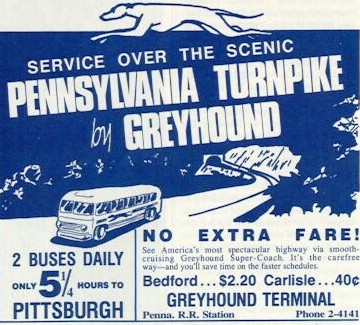
Advertisements like this began to appear in
the Harrisburg newspapers.
(State Library of Pennsylvania)
Still protesting the truck toll rates, the Pennsylvania Motor Truck Association (PMTA) continued to urge its members to boycott the new Turnpike while they kept negotiating for a reduction. They pleaded with the PTC that many operators could not afford the rates. However, the advantages in delivery time, fuel savings, and driver comfort proved to be a more attractive point and within weeks, interstate and intrastate trucks without regulatory limitations became drawn to the Turnpike by the thousands.
| TRAFFIC POINTS OF ENTRANCE AND EXIT There are eleven (11) Interchanges located at selected points along the Turnpike route. These Interchanges have been strategically located so that they offer convenient connections with existing highways. The following diagrams show the eleven (11) points of exit and entrance with a brief description of the traffic flow for each. Each Interchange, as shown, is self-explanatory through the use of directional arrows and appropriate description for each direction of traffic--for entering and leaving the Turnpike. If there are any questions relative to reaching your destination they will be answered by the ticket-office or service station attendant. |
|
 |
This interchange makes a direction connection with U. S. Route No. 30 (Lincoln Highway). Traffic to and from the Turnpike for points of destination are shown by the directional arrows. The ticket office at the western terminus is located directly across the Turnpike proper on 6 traffic lanes. All other ticket offices, except at Carlisle Interchange, are located off the Turnpike on spur lanes provided for entrance and exit. (MILE 0) |
 |
This Interchange, being located on the heavily traveled U. S. No. 119, will serve to expedite traffic east and west across Pennsylvania from southwest to the east and vice-versa. Note ticket office is off the Turnpike proper. Follow directional arrows for correct guidance. (MILE 8) |
| New Stanton Gas Station
(W-B) MILE 11 |
|
 |
This Interchange being located in a mountainous region and in the heart of a vacation-land serves as a direct connection to the nationally known town of Ligonier twelve miles north of this point. The annual Rolling Rock Horse Show is held in this community. (MILE 24) |
| Laurel Hill Tunnel--4,541
feet MILE 33 |
|
| Laurel Hill Gas Station
(E-B) MILE 36 |
|
 |
Somerset Interchange is located north and adjacent to the town and will serve as a direct connection to north-south traffic traveling on U. S. Route No. 219. Directional arrows point out destinations and mileage from this Interchange. (MILE 43) |
| Somerset Gas Station
(W-B) MILE 45 |
|
| Allegheny Tunnel--6,070
feet MILE 56 |
|
| New Baltimore Gas Station
(E-B) MILE 63 |
|

|
The Interchange is located at the mid-point between Harrisburg and Pittsburgh. It makes a direct connection to the heavily traveled U. S. Route No. 220 for north-south traffic and is only two miles north of the nationally known resort town of Bedford. (Considerable traffic will flow from the south through Bedford to this Interchange for east-west destinations.) (MILE 79) |
| Midway Gas Station
(E-B/W-B) MILE 80 |
|
 |
The Interchange is conveniently located with a direct connection to the Lincoln Highway--U. S. Route No. 30. It will absorb and discharge a considerable volume of traffic using Pa. Route No. 126, which leads directly south into Maryland and Virginia, as well as from the normal flow of traffic on the Lincoln Highway proper. (MILE 96) |
| Rays Hill Tunnel--3,532
feet MILE 98 |
|
| Sideling Hill Tunnel--6,782
feet MILE 103 |
|
| Cove Valley Gas Station
(W-B) MILE 105 |
|
 |
The above traffic facility located near Ft. Littleton on U. S. Route No. 522 will serve a north-south influx of traffic desiring direct connections with east-west destinations. It is anticipated that considerable hauling of coal from the famous Broad Top Coal Fields will use this Interchange for east-west distribution. (MILE 115) |
| Tuscarora Mountain Tunnel--5,326.5
feet MILE 120 |
|
| Path Valley Gas Station
(E-B) MILE 121 |
|
 |
The Willow Hill Interchange is provided to serve several connecting valleys throughout this area, which, during various seasons of the year receives a great amount of tourist travel on Pennsylvania Route No. 75. (MILE 124) |
| Kittatinny Mountain Tunnel--4,727
feet MILE 131 |
|
| Blue Mountain Tunnel--4,339
feet MILE 132 |
|
 |
Blue Mountain Interchange is located two miles east of the Blue Mountain tunnel, making a direct connection with Pennsylvania Route No. 944, for points south by way of the Shenandoah Valley, and traffic from other routes such as the Lincoln Highway passing through Chambersburg, which is only fourteen miles south of this Interchange. (MILE 134) |
| Blue Mountain Gas Station
(W-B) MILE 136 |
|
| Carlisle Gas Station
(E-B) MILE 152 |
|
 |
This Interchange is located north and adjacent to the historic town of Carlisle which in reality is the gateway to the west for traffic from all points east, as shown above. The 4-lane ticket office is located directly across the Turnpike proper, as is the ticket office at Irwin. Traffic desiring to proceed westward from this Interchange will follow the directional arrows as noted. (MILE 157) |
 |
The present eastern terminus of the Pennsylvania Turnpike is located at Middlesex, just two miles beyond the Carlisle Interchange, making a direct connection with U. S. Route No. 11 for points north and east, as shown. No ticket booth was provided for this Interchange due to its close proximity to Carlisle. When the Turnpike is extended to Philadelphia this Interchange may be eliminated. The foresight and discretion show by the Commission in its planning will prove economical. (MILE 160) |
|
†All
distances to tunnels are given to middle of each tunnel. |
|
The weekend of October 5 and 6 was the first chance many people got to traverse this gem of a highway for the first time. Even though the day turned out to be pleasant in terms of the weather, it would not be as pleasant for the Turnpike Commission. The amount of traffic in the morning was light, but by afternoon the numbers grew with after-church and after-Sunday dinner motorists flocking to the interchanges and throwing them into pandemonium. Three of the interchanges ran out of passenger-car toll tickets and had to resort to giving light truck tickets or hand-written notes.
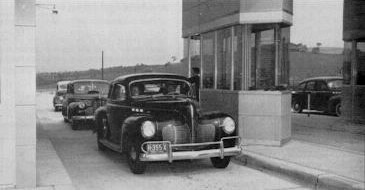
Hexagonal toll booths on the original Turnpike.
(Pennsylvania Turnpike Commission)
The largest problem that occurred wasn't trying to get traffic onto the highway, but trying to get the traffic off the Turnpike. Traffic would back up for miles at all of the interchanges waiting to get off, as the time to collect the ticket and toll and giving change when needed took longer than handing a motorist a ticket. The attendants were so busy that they couldn't even break for lunch, and some were seen eating a sandwich with one hand while handing out tickets with the other. Employees of the PTC expecting to go out for a cruise with their families were pressed into service directing traffic at the Carlisle Interchange. The jams were so bad that all 59 Pennsylvania Motor Police officers assigned to the Turnpike were on duty trying to ease the back-ups. A traveler from Johnstown said he waited four hours and 50 minutes in line to leave at Somerset. Back-ups at Bedford and Carlisle totaled six and three miles respectively. The tunnels also saw the same amount of congestion as two lanes went into one to go through them. However, the PTC not only did a booming business in terms of toll revenue, but also from sales at the Standard stations with 50,000 gallons sold that day.
The Bedford Gazette observed that many travelers did not intend to travel the entire length of the highway, but rather a small portion was the cause for the traffic jams. Many people entered at Irwin and planned to exit at Somerset, with their return trip back over the Turnpike. However, when the approached the interchange and witnessed the hundreds of cars backed-up, decided to continue on to Bedford. Then arrived there to find the jam up even worse than the one at Somerset. According to the Harrisburg Evening News, Carlisle Pike (US 11) was "black with automobiles traveling to and from the turnpike." Harrisburg police had to work a double shift to handle the traffic in the downtown that spilled over from the Turnpike. The jams began to ease between 10:30 PM and midnight, with early estimates ranging from 10,000 to 12,000 vehicles. However, when the tickets were finally counted, the total came to 27,000 with only one minor accident reported.
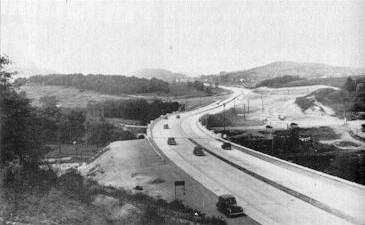
Curved viaduct east of New Stanton.
(Pennsylvania Turnpike Commission)
After the hectic weekend had passed, Governor Arthur James became the first celebrity to take a ride down the Turnpike on October 8. He was returning to Harrisburg after visiting an ill friend at the Mayo Clinic. The Governor flew to Chicago where he took a Pennsylvania Railroad train to Pittsburgh, then he drove to the capital at 50 MPH which he himself decreed the maximum to be on the highway just weeks earlier. Four hours later he arrived at the Carlisle toll plaza and declared the Turnpike to be "a peach of a road." He also commented on what is now called "highway hypnosis" by saying he had "the most somnolent trip I've ever taken" and suggested that "(t)hey ought to give everybody a cup of coffee before they go onto the Turnpike to keep them awake." For those wondering, his toll was waived: "They told me I'm the only man privileged to sign my name."
At the same time the governor was doing his own test drive, the Commission was gearing up for the coming weekend. Workers added temporary toll booths and asphalt lanes at all of the interchanges except Irwin's, and more toll tickets were printed. Its a good thing too, because on the second Sunday of operation, 30,000 vehicles passed through the toll plazas but without the congestion of the previous weekend. There was some trouble getting from the booths onto the state highways and into the towns near the interchanges. In the end, the towns came out on top with motels, tourist homes, and restaurants packed with travelers. The same business that worried the Turnpike would take business off of US 30. Some motorists still did not understand the expressway concept. One drove the wrong way on an exit ramp at Middlesex and wound up in a minor accident, and another pulled up to the Carlisle toll plaza asking how to get onto the Turnpike.
The Turnpike officials released the figures showing that in just four days of operation, the highway had carried 24,000 vehicles or about 6,000 a day. That was nearly double the number that was forecasted but the Turnpike's own traffic planners. With the weekend numbers of tourists and sightseers added to that, the number jumped to 150,000 for the first 15 days of operation, or about 10,000 per day. Many of these trips were one-time curiosity trips, and were unlikely to mirror any trend in a normal day of operation.
The number defied the dire predictions that the US Bureau of Public Roads, predecessor to the Federal Highway Administration, gave of 715 cars a day. Their position was not only anti-toll highway but also against intercity limited access highways, either toll or free. At the same time Pennsylvania was building their highway, President Franklin Roosevelt asked the Bureau's director, Thomas H. MacDonald, to conduct a study into building six national toll highways: three east-west and three north-south. MacDonald believed that toll highways would never attract enough customers to repay their construction costs, and instead backed the improvement of urban highways as more important. However, he did agree that a national system of highways was useful, but only ones with two lanes would be needed for much of the distance. This at a time when the total distance of four-lane highways measured 11,000 miles, among the three million miles of highways in existence in the United States. The results of the study were in a report to Congress titled Toll Roads and Free Roads. In Bruce E. Seely's 1987 book titled Building the American Highway, he noted that the Bureau's report "attacked a national system of toll superhighways as wasteful, presenting traffic estimates that showed that only 3,346 of the proposed 14,336 miles required more than two lanes. Only 547 miles, it predicted, would return more than 70 percent of the receipts needed to retire the construction bonds, and only the 172 miles from Philadelphia to New Haven (Conn.) might break even. BPR analysts assumed that public resistance to tolls would deter traffic and that limited access would prevent superhighways from serving the local traffic that formed the majority of all trips, even if motorists wished to use them. The BPR simply believed toll highways were unprofitable."
The study separated the six toll highways into 75 segments and estimated that the portion comprised of the Turnpike would rank no higher than 19th in traffic volume. The majority of cars owned at the time belonged to families with an income of no more than $1,500/year. The report said, "The cost of gasoline consumed on a trip may amount to a little more than a cent a mile. To the motorcar owner with an income of less than $1,500 a year, a toll of one cent per mile is likely to appear as a 100 percent increase in his cost of operation. He would view this as an additional cost that he is not likely to pay."
Of course, the traffic counts produced by the Turnpike that confounded the critics, is what Phil Patton cited in his 1986 book Open Road. "The BPR had no notion that the construction of new superhighways, like the introduction of such inventions as the telephone and the auto itself, might create its own demand."
One of the effects of the Turnpike's success was how it altered the course of national highway policymaking. MacDonald's thinking was based more on the transportation needs of 1930s America, before two factors of long distance motoring that would grow in the post-war United States: rise of the trucking industry, and recreational travel. In the end, MacDonald was so wrong about toll highways that his agency lost clout in setting the federal government's highway agenda, and marked a historic turning point. From that time on, the decisions would be made increasingly by officials sensitive to the voters, rather than just the engineers. With the vigor of the Turnpike's success on their side, Roosevelt and Congress went back to the drawing board with the information contained in Toll Roads and Free Roads. This would eventually become the blueprint for today's Interstate Highway System.
The impact of a superhighway available to carry goods safely was felt by a 19-year-old Bill Yocum. He was a truck driver who hauled Chrysler automobiles from Detroit to the port at Buffalo to Washington, DC. K.U.K. Auto Transit of Williamsport, the company he worked for, avoided operating over the shorter but mountainous US 30, and preferred to use US 6 through the northern tier of Pennsylvania, then down the Susquehanna River valley to Harrisburg. US 22 was not considered a statewide trucking corridor because of a low-clearance underpass in Huntingdon. When the Turnpike opened, the company began using it and Yocum got to experience the highway's first winter first hand. "I can remember sitting in one of the Turnpike restaurants with other drivers on a snowy night, and our conversation was about the fact that we wouldn't be out driving at all if it weren't for the Turnpike. These winter nights when ordinarily truckers would simply have to tie up." Yocum would later become president of the Pennsylvania Motor Truck Association (PMTA), commented that the highway cut a full day off the round-trip journey between Detroit and Washington.
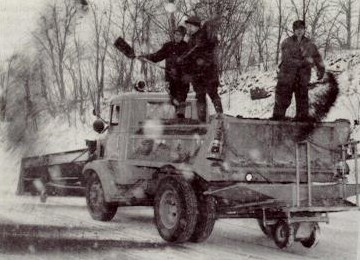
Winter maintenance in the early days.
(Pennsylvania Turnpike Commission)
He also commented on when trucks carrying flammable or explosive cargo were allowed to travel through the tunnels, after traffic was stopped in both directions. The practice was stopped less than a year after the highway opened, whether due to traffic disruption or because of the hazard. Ever since then, those types of cargo have been prohibited from using the tunnels.
It wasn't only the truckers who were impressed, but also the motoring public. One of them on October 31, 1940, wrote on a Turnpike postcard mailed from Camp Hill to Pittsburgh: "We came through the tunnels. The lights make them like a fairy land." Even a Ford Motor Company publication exalted the highway as "the closest the average American comes to breaching the sonic barrier is when he eases himself behind the wheel of the family car (no doubt implying a Ford) and has a go at the Pennsylvania Turnpike."
|
|
At the end of 1940, the traffic totals looked like this: 514,231 cars, 48,170 trucks, and 2,409 buses. From these users, the total revenues equaled $562,464, but it didn't mean that these drivers had adjusted to the skills needed for high-speed, quick reaction situations. It definitely did not compensate for the fact that cars of the time were not built to go 80 MPH, or even 60 MPH for that matter. Magazines at the time reflected this in stories they did about the Turnpike. Fortune noted: "The Turnpike is the first American highway that is better than the American car. As such, it will represent the maximum in road construction for many years. It is proof against every road hazard except a fool and his car." Engineering News-Record noted this: "Excessive speed on the Pennsylvania Turnpike has been checked more by the experience...that cars and tires do not stand up under high sustained speed...than by any other means." Tire blowouts and engines overheating were common along the highway. It was not speed or a tire blowout, but icy conditions that led to the first fatality on the Turnpike when Arthur B. Turner, 66, of Bethlehem lost control of his car and struck a center bridge pier one and one-half miles west of Donegal. He was pronounced of dead of a skull fracture after being admitted to Westmoreland Hospital in Greensburg.
The year of 1941 brought about a resolution between the PTC and the Pennsylvania Motor Truck Association over the toll rates for trucks. A plan for reduced tolls was agreed upon, which meant that carriers that were volume users would get a discount of as high as 20%, and monthly fleet billings were also made available.
April 15, now known as income tax day, was instead a welcome day in the year 1941. On that day, Governor James signed Act 10 which implemented a 70 MPH speed limit for personal automobiles, and a truck speed limit that varied between 50 and 65 depending on the size and weight. The only decrease in the speed limit along the Turnpike was at the tunnels, when it dropped to 35 MPH.
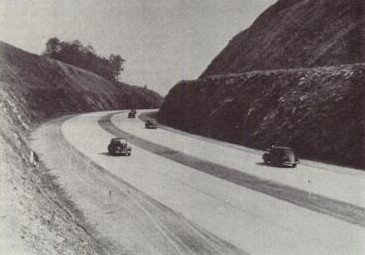
Clear Ridge Cut
(Pennsylvania Turnpike Commission)
With the Turnpike level of service well established, the media and public both looked toward the benefit of extending the comforts of superhighway travel east to west and north to south. Even before the first car tires made contact with the Turnpike, Chairman Jones his own proposal for a 1,800-mile, $860 million system of toll expressways from Richmond, Virginia to Boston; Philadelphia to St. Louis (incorporating the Turnpike); Pittsburgh to Chicago and Indianapolis to Chicago which looked similar to the Pennsylvania Railroad system map. Jones wrote of this vision, "However advantageous, it is hardly possible that any of the states will be able to contribute much to the development of a national system of super-highways...our task is a national one and the understanding of this need must be brought to the attention of Congress in a convincing manner. A little under two decades later, the Interstate Highway Act would use this information to establish a 90%/10% federal-state cost-sharing formula.
Although he had planned an expansion to points outside of the Commonwealth, the most important extension planning would be for intrastate highways. Four months before the Turnpike opened for business, Governor James signed Act 11 which authorized a extension eastward to Philadelphia. In an message to the state legislature on January 7, 1941, Governor James asked the law makers to get federal approval to "extend Skyline Drive from Front Royal, Va., along the crest of the Pennsylvania mountains, to the Delaware Water Gap...and second, that the federal government give consideration to a new superhighway for Pennsylvania to extend from our ocean port at Philadelphia to our lake port at Erie." With the Turnpike open for less than a year, on June 11, 1944 he signed Act 54 which authorized the Western Extension.
This was based more on the performance
of the highway so far. In the first 12 months of operation, 2.4 million
vehicles, nearly twice the projection of 1.3 million, passed through toll
plazas up and down the system. However, this volume would start to
trail off as the United States was pulled into World War
II.
From the day when the Turnpike welcomed its first customers, the thoughts in the back of people's minds were of what was occurring across the Atlantic. Reports of Britain's five hour bombing of Berlin and Germany's latest bombing of London shared the front page with the highway's opening. With the specter of war looming over the US, changes came swiftly to the Turnpike. The number of troop and material movements increased, while the number of civilian trips decreased.
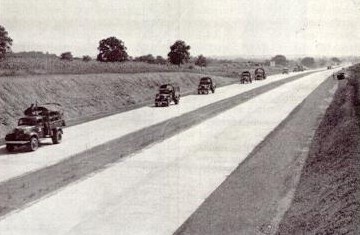
Military convoy on the Turnpike.
(Pennsylvania Turnpike Commission)
The Federal Office of Defense Transportation imposed a 35 MPH speed limit on all highways beginning in December 1941, with war supply movements exempted. Gasoline and tire rationing began in March 1942. It didn't take long after those two major impediments to travel to show up in toll receipts. Use of the Turnpike fell a whopping 70% from 2.1 million in 1941 to just 581,000 in 1943.
The number of trucks on the highway increased from 48,000 in 1940 to about 300,000 in 1942, and remained consistent through the war. Not only did revenue drop, resulting in the PTC dipping into financial reserves to pay the bond obligations, but also the number of troopers patrolling the highway. Some went off to war and other were not required as the level of traffic did not warrant the level of supervision that pre-war traffic did. From the initial 59 troopers that were brought on when the highway opened, the number fell to 48 in 1941, 26 in 1942, 20 in 1943 and 1944. The men who pumped the gas at the service plazas also heard Uncle Sam's call to arms. Just like in every other "home front" duty, women replaced the men at the pumps.
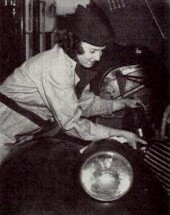
One of the many
women who took over
at the pumps. (PTC)
Even with the decreased number of troopers on the Turnpike, there was one place their numbers increased: the tunnels. With the possibility of sabotage, special details of the motor police were posted at the entrances to inspect any vehicles that appeared to be or whose driver acted suspicious.
Many publications hailed the Turnpike
as a savior to the world during the war. The Highway Builder, the
Pennsylvania construction industry's magazine said, "Should the conflagration
now destroying Europe ever blaze across the Atlantic to sear these shores,
the Pennsylvania Turnpike would ably demonstrate its ability to carry adequately
the heavy gear of war." Another magazine said, "Over the Pennsylvania
Turnpike (costing less than one battleship) a great army could be rushed
eastward from beyond the mountains in the shortest possible time." Seeing
the potential military value of the Turnpike, in 1944, Congress passed a
bill that outlined a national system of limited-access highways which became
a basis for the Interstate highway act that would be passed a decade
later.
When the boys came back from the front, the nation was ready to get back to normal. The Pennsylvania Turnpike Commission was also looking forward to a normal pace, which meant getting ready for the return of civilian use and reviving plans to expand the system. A setback occurred when Walter Jones, the first chairman and architect of a plan for a 1,800-mile-long system of toll expressways that would serve 40% of the nation's population, had fallen ill and resigned in 1942 and then effective on September 1, 1943, his commission seat. Three days later he died. Two other original members, Frank Bebout and Charles T. Carpenter, died earlier. In 1946, Governor Edward S. Martin filled the vacancies, and the new commission picked up from where Jones left off.
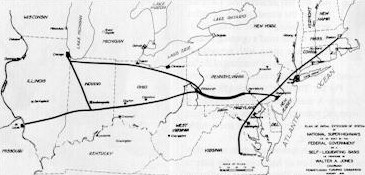
Walter Jones' original plan for a 1,800-mile-long
system of Eastern and Midwestern toll highways.
(Pennsylvania Turnpike Commission)
In 1946, the same year tire rationing ended, the highway handled 2.4 million vehicles, which was about the same number that used it in its first year. The same year, the Commission decided to do some financial "housekeeping." The Commission decided to issue new bonds with their financier Fidelity-Philadelphia Trust Company. The new two and one-half percent interest rate would help raise capital to retire the old bonds. There was one problem: this arrangement restricted the use of all revenue to the original Turnpike section.
To get around this stipulation, the PTC set up three separate operating and accounting divisions, each with its own bond issues to get extensions to Philadelphia and Ohio underway. The last piece of the puzzle was to get legislation to approve this, which occurred in 1947 when Governor James H. Duff signed a law that merged the proposed eastern and western extensions and the existing highway into one body. This piece of legislation was known as the Trust Indenture of June 1, 1948. A total of $87 million worth of bonds were sold to help get the Philadelphia Extension going, which was a 100-mile-long section from Middlesex to King of Prussia. Ground breaking ceremonies took place on September 28, 1948 in York County. All this was happening as more people flocked to the original highway. In 1949, before any of the extensions opened, the Turnpike handled 3.8 million vehicles which was three times what the planners envisioned.
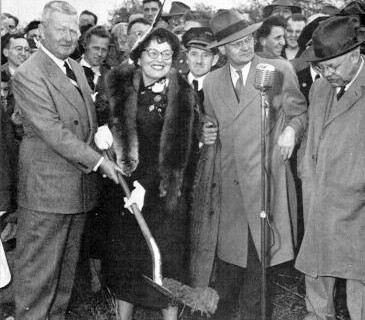
Governor James Duff and his wife Jean Taylor
Duff with the first shovel of earth at the ground
breaking for the Philadelphia Extension.
(Pennsylvania Turnpike Commission)
Pennsylvania's success with the toll highway concept influenced other states to follow suit. Maine became the first in 1945, when it authorized a 47-mile-long project paralleling US 1. The other states that followed included Colorado, Florida, Indiana, Kansas, Maryland, New Hampshire, New Jersey, New York, Ohio, Oklahoma, Texas, and West Virginia.
In 1946, the Turnpike was recognized by a competitor: the Pennsylvania Railroad. In a corporate history published for the PRR's centennial, authors George H. Burgess and Miles C. Kennedy told of William Vanderbilt's South Pennsylvania Railroad: "Nearly 100 years later, when the South Penn(sylvania)'s name was almost forgotten...much of the old right of way, with its grading and uncompleted tunnels, would fit into a scheme for a superhighway between Harrisburg and Pittsburgh, so at last events went through the full cycle...now highway vehicles supply the competition for which the South Penn(sylvania) Railroad was designed."
For construction workers building the Philadelphia Extension, the project was not a daunting task. They did not have to endure excavating tunnels through mountains as workers did on the original Turnpike; however, they did have to deal with the Susquehanna River. Engineers designed a 4,526-foot-long bridge, with steel girders resting on concrete piers. The $5 million bridge was supplied and erected by the Bethlehem Steel Corporation, whose Steelton plant is where the eastern end of the bridge passed through. However, only the handrails were fabricated at that plant. In all, 28 contracts were awarded to 17 companies for the construction of the extension, which took two years to build like the original Turnpike. The Philadelphia Extension opened to traffic on November 15, 1950 with the exception of the Gettysburg Pike Interchange which opened on February 1, 1950. To accommodate the extension, the original mainline toll plaza that extended across the highway was demolished and the ramps to Carlisle closed. The Middlesex Interchange was upgraded with a new toll plaza and ramps, and renamed the Carlisle Interchange.
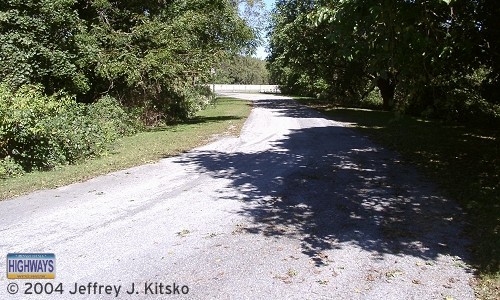 Former eastbound off-ramp to the traffic circle in Carlisle west of PA 34. |
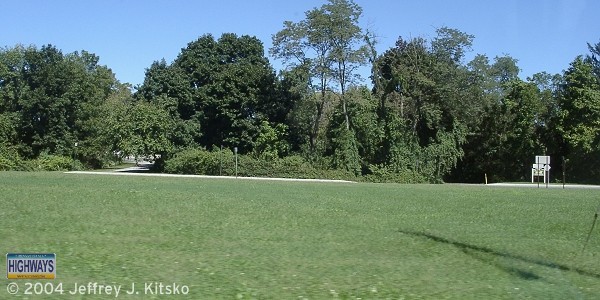 Looking across the traffic circle at the off-ramp. On the right is Cave Hill Road, which was the on/off-ramp to/from the Turnpike. |
With the extension's opening, the eastern terminus of the Turnpike now lay only 15 miles northwest of Philadelphia's central business district. By the end of 1950, even without the contribution of traffic from the new extension, the Turnpike had handled 4.4 million vehicles.
|
|
|
The Western Extension proved to be another challenge for engineers and construction workers alike. The right of way covered more rugged territory than the Philadelphia Extension did, and crossed two major rivers. A 2,180-foot-long bridge was constructed over the Allegheny River at Oakmont, and a 1,540-foot-long bridge over the Beaver River north of Beaver Falls. In order to provide enough right-of-way for the road, the eighth green at the famed Oakmont Country Club, site of numerous US Open golf tournaments, had to be moved. The extension opened in sections: Irwin to Pittsburgh on August 7, 1951; then from Pittsburgh to the Gateway Interchange on December 26, 1951. The only exception was the Beaver Valley Interchange which opened on March 1, 1952. When this section opened to traffic, it dumped torrents of traffic onto Petersburg, Ohio which would last three years until the Ohio Turnpike opened on December 1, 1954.
|
|
Just as the changes at Carlisle were needed for the Philadelphia Extension, the same had to be done at Irwin. However, this time, the original booths were not demolished as the new extension passed to the east of them. Connecting ramps and an overpass were constructed to and from the toll plaza.
The engineers who designed these two extensions modified the designs that were used for the original Turnpike. Adjustments to the concrete used for the roadway and an additional sub-base was laid for better drainage. Larger service plazas were constructed, and as early as 1946, some of the older plazas were expanded to handle more people and a full meal service instead of just a coffee-shop menu. Pittsburgh based Gulf Oil secured the rights to provide gasoline at the service plazas on both extensions, and as Standard Oil did, subcontracted the restaurant services to Howard Johnson's. The overpasses also changed design from concrete arched bridges to all steel construction on the Western Extension. The design specifications also differed on the extensions: Philadelphia has grades of two percent and curves of three degrees, and the Western has grades of three degrees and curves of four degrees. A far cry from the original's specifications of grades of three percent and a maximum curve of six degrees.
The year's traffic count reflected the growth of traffic using the Turnpike. Even with the Western Extension being open for six days of 1951, the traffic count was 7.4 million with the addition of the Philadelphia Extension. It would not be until both extensions were open for an extended period, stretching 327 miles across the Commonwealth of Pennsylvania, that the count would be pushed to 11 million vehicles.
With the completion of the Western Extension, the only logical way to expand was to New Jersey. A 33-mile-long section from the Valley Forge exit to Bristol and a proposed crossing of the Delaware River. With a bridge, travelers could access the New Jersey Turnpike, thus making it possible to travel from New York City to the Ohio line. In May and June of 1951, Governor John S. Fine signed a bill to construct the Delaware River Extension and a joint toll bridge with the New Jersey Turnpike.
Everything seem fine; however, there was a problem. The 1948 indenture under which the Philadelphia and Western Extensions were financed allowed additional expansions. The problem was work could not start on a new extension until the previous project was open to traffic for two years, which would mean waiting until 1954 to begin financing. Governor Fine signed a bill in August of 1951 to move the timetable up, so he signed the Indenture of September 1, 1952. It was a supplement to the bill of 1948 and was intended to be used for future expansion.
To finance the Delaware River Extension, the PTC issued $65 million worth of bonds in September of 1952. The current configuration at the Valley Forge Interchange had to be converted from a terminus to an "off-line" interchange. It was built to connect to a future highway that would connect the Turnpike to Philadelphia: the Schuylkill Expressway.
The 1,224-foot-long bridge over the Schuylkill River was the longest structure on the extension. On August 23, 1954, the Delaware River Extension opened to the Norristown and Willow Grove Interchanges. The remaining interchanges opened as follows: Fort Washington on September 20, Philadelphia on October 27, Delaware Valley on November 17.
While the celebration of the opening was taking place, the Pennsylvania Turnpike Commission was not only looking to building the Delaware Bridge but also a spur to Scranton. The proposal of a spur to Scranton was not a new idea, it had been authorized as early as 1947. In 1954, the commission combined the financing of both projects into one $233 million bond.
The ground breakings for both proposals were held on March 25, 1954 for the Northeast Extension and June 22, 1954 for the Delaware River Bridge. The bridge was constructed and jointly financed by the New Jersey Turnpike Authority and the Pennsylvania Turnpike Commission. It cost $27,200,000 and opened on May 23, 1956 at 11:30 AM when Governors George M. Leader of Pennsylvania and Robert B. Meyner of New Jersey met in the middle of the span to cut the ribbon. The bridge is 135 feet above the Delaware River because of the ship traffic that utilizes the river. The significance of the bridge is that it would soon be possible to travel between Maine and the Indiana-Ohio border (and soon to Chicago with the completion of the Indiana East-West Toll Road) without encountering a traffic light, cross street, or grade crossing.
The first section of the Northeast Extension opened on November 23, 1955. Its initial 37 miles opened from an interchange east of the Norristown Interchange to the Lehigh Valley Interchange. Interchanges at Lansdale and Quakertown opened later on December 3 and December 10, respectively. From the Lehigh Valley Interchange, another ten miles opened to a temporary interchange at Emerald on December 28, 1955. Work was still taking place to build the two-lane, 4,461-foot-long tunnel through Blue Mountain. It was named Lehigh Tunnel so as not to be confused with the tunnel through the same mountain on the mainline Turnpike. It would been named after commission chairman Thomas J. Evans if he hadn't been convicted of conspiracy to defraud the PTC of $19 million on July 25, 1957.
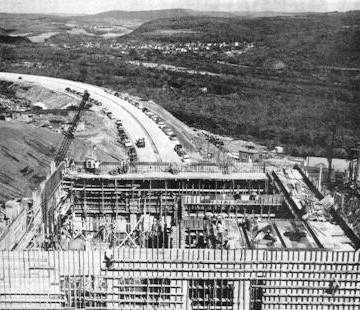
Construction of the Lehigh Tunnel.
(Pennsylvania Turnpike Commission)
On April 1, 1957, the Northeast Extension was opened to the Wyoming Valley Interchange near Wilkes-Barre. At this time, the temporary interchange at Emerald closed. The last 16 miles to Scranton opened on November 7, 1957. With the opening, it brought the Northeast Extension's total length to 110 miles, and the total system length to 470 miles.
With all the excitement over bond issues and expansion, people forgot about one point. The original planners anticipated that the Turnpike would retire its debt by 1954 and thus be turned over to the state as a free highway. But those pioneers of superhighway planning could not foresee postwar economic inflation, rise in traffic flow, and the need to expand.
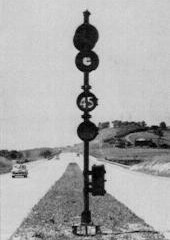
Railroad-like signals
indicated the 45 MPH
speed limit on bridges.
(PTC)
The Northeast Extension was not the only branch to be proposed. Many extensions were drawn in the 1940s and 1950s, and even some received legislation. In a 1954 Turnpike brochure was the sentence. "When finally completed, the Pennsylvania Turnpike will consist of more than 750 miles." Some Turnpike maps even had over 1,000 miles as a target length.
Here is a list of the proposed routes the Turnpike Commission
considered:
These plans never came to be as toll expressways. By the time 1954 came around, support for toll highways died down, and on June 29, 1956 President Dwight D. Eisenhower signed the Interstate Highway Act. This set up the financing for $25 billion in federal funding for a national system of four lane, controlled-access free highways. By offering 90% of the funding, states jumped on the bandwagon and abandoned plans for toll highways.
The 1958 Annual Report stated about the extensions: "In all of the authorized and previously authorized proposed extensions, the Turnpike Commission is empowered to determine the exact routes with the approval of the Governor and the Secretary of Highways, nevertheless construction cannot be started until the project is determined to be feasible and has been financed. The feasibility of any of these extensions will be influenced by the program of the National System of Interstate and Defense Highways." They didn't know that half of it, as eventually these extensions were built; however, not all with the help of the Interstate Act.
TURNPIKE EXTENSIONS PRIOR TO 1956 |
|
Extension Name |
Highway It Became |
Scranton Extension |
|
Philadelphia Loop Extension |
|
Chester Extension |
|
Gettysburg Extension |
|
Northwestern/Southwestern Extension |
|
Northwestern Extension |
|
Sharon to Stroudsburg Lateral Connection |
|
While the Turnpike Commission was
looking towards expansion, two service plazas were closed in 1957. The
Laurel Hill just east of the Laurel Hill Tunnel and New Baltimore both on the
eastbound side of the Turnpike.
As the Turnpike was preparing to count its 200 millionth vehicle, it was apparent that something had to be done to bring the growing traffic count under control. Now that the annual volume was running at 31 million vehicles, 24 times what the planners envisioned, congestion began to grow. The largest contributor to the congestion were the east-west tunnels. Beginning in 1951, eastbound traffic would begin to backup at the Laurel Hill tunnel during summer weekends, and by 1958 it was a common sight anytime between June and November. The jams would stretch as far as five miles back from the mouth of the tunnel waiting to squeeze from two lanes into two, which made PTC officials look toward eliminating these bottlenecks.
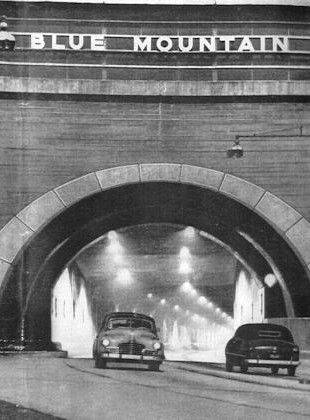
A picture illustrating the dangers of the two-lane
tunnels. (Pennsylvania Turnpike Commission)
Not a minute too soon either, as the New York Thruway began to slice into the Turnpike's profit. Built according to the new Interstate standards, it was a far cry from two-lane tunnels and narrow median strip on the Turnpike which PTC officials publicly called obsolete.
If the New York State Thruway wasn't enough competition for the Turnpike, it got some from another highway in its own state. On March 19, 1959, the ground breaking for Interstate 80/Keystone Shortway took place. Originally proposed as the Turnpike's Sharon to Stroudsburg Lateral Connection, the project was handed over to the Department of Highways to be built as part of the Interstate system. Philadelphia city officials, including Mayor Richardson Dilworth, opposed I-80 because it would divert revenue from the Turnpike and freight from the Delaware River's docks to New York City's. This was a kind of revival of the trade rivalry of the 1830s between the two seaports.
Studies began in the mid-1950s to determine what exactly to do with the tunnels, and the first two studied were the Laurel Hill and Allegheny Mountain Tunnels. It focused on the cost of benefits of building a two-lane parallel tube at both locations, with additional studies conducted for Rays Hill, Sideling Hill, Tuscarora Mountain, Kittatinny Mountain, and Blue Mountain.
The conclusion of the study ushered in a $100 million program that would last at least a decade. The first order of business was to construct a three-mile-long bypass over Laurel Hill and around the tunnel, which would be closed. Construction began on September 6, 1962, and the new alignment complete with a broad median and a truck climbing lane in each direction opened on October 30, 1964. The new section became the highest elevation on the Turnpike system at 2,603 feet, up from the old record of 2,200 feet in the Laurel Hill Tunnel. A 145-foot-deep cut was chiseled out of the mountain top, nearly as deep as the Clear Ridge Cut that was located on the original 1940 Turnpike east of Everett. In clearing this cut, 5.5 million cubic yards of earth and rock were removed, five times the amount removed at Clear Ridge.
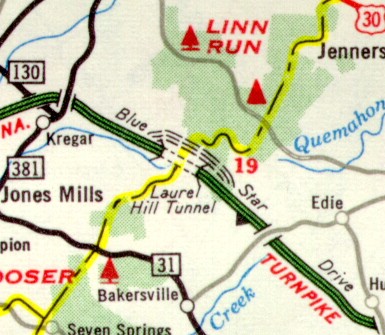 Laurel Hill Bypass indicated as under construction on the 1964 official state map. (Pennsylvania Department of Highways) |
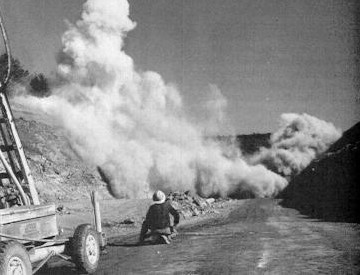 Blasting at the Laurel Hill Bypass work site. (Pennsylvania Turnpike Commission) |
The second project to take place was the excavation of a second two-lane tunnel at the Allegheny Mountain Tunnel, which became the westernmost tunnel on the system with the closing of the Laurel Hill Tunnel. For a period, engineers wanted to utilize the never-completed South Pennsylvania railroad tunnel that lay adjacent to the tunnel. However, it was rejected this time for the same reasons it was rejected in 1939. The new tunnel cost $8.3 million and was carved out of the mountain 125 feet south of the original tunnel.
|
|
|
|
Many improvements over the original tube were made during the construction of the new tunnel. The most noticeable change was the brighter interior produced by the white-tile walls and fluorescent lighting. For the Turnpike maintenance crews, it was easier to maintain and clean than the old recessed lighting in the dingy concrete lining. The ventilation was improved with a more powerful system, increased clearances, and a completely new portal building and control center. The new tunnel opened to traffic on March 15, 1965, at which time the old one was closed for a $3 million revitalization project to bring it up to its twin's standards. The original tube reopened on August 25, 1966, and for the first time in the Turnpike's history, provided a trip through a tunnel not having to endure a merge at the tunnel's entrance.
While the opening of the new tunnel at Allegheny Mountain was taking the spotlight, studies were being conducted on what should be done with the remaining tunnels on the system. Parallel tunnels were shown to be the most economical solution to three other sites: Tuscarora Mountain, Kittatinny Mountain, and Blue Mountain. The first spade of dirt to be shoveled in the next round of tunnel construction occurred on April 11, 1966 just north of the original Tuscarora Mountain Tunnel when the $9.8 million project began. A week later, ground breaking took place for a $16.3 million project to bore tunnels south of the original Kittatinny Mountain and Blue Mountain Tunnels.
|
|
With the work on the Allegheny Mountain Tunnel completed, Laurel Hill Tunnel bypassed, and work underway to "twin" the Kittatinny, Blue, and Tuscarora Mountain Tunnels, attention focused on what to do with the remaining two mainline tunnels. An engineering report conducted by Buchart-Horn released in February 1961 produced five alternatives for congestion relief:
The Turnpike Commission concluded that the most efficient means of easing the congestion at the longest and shortest Turnpike tunnels, Sideling Hill (6,782 feet) and Rays Hill (2,532 feet) respectively, was to build a new 13.5 mile bypass. The commission awarded three contracts from July 1966 to March 1967 totaling $17.2 million for the roadway construction and another $2.5 million for a new Sideling Hill Service Plaza to replace the Cove Valley Service Plaza along the section of highway being replaced. The new plaza would be built with crossover ramps allowing it to serve both directions of travel.
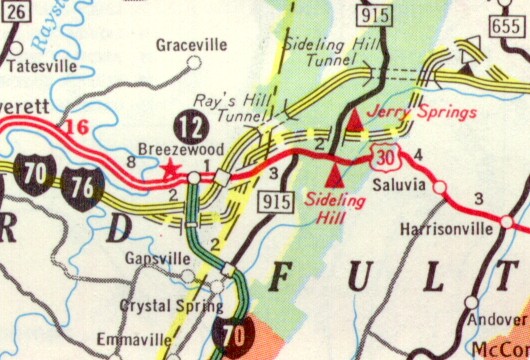 Rays Hill-Sideling Hill bypass as indicated on the 1968 official state map. (Pennsylvania Department of Highways) |
|
|
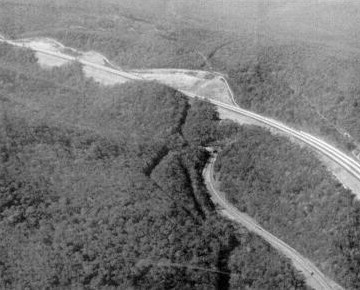 The new Turnpike alignment passing over the Sideling Hill Tunnel. (Pennsylvania Turnpike Commission) |
As for design standards, the same used at Laurel Hill's bypass were also utilized in this project. Engineers kept the three percent grade, a wide median strip, and a third truck-climbing lane at each end of the new roadway. Going from west to east, the new alignment loops south of the existing highway, then crossed over to the north above Sideling Hill Tunnel which is six tenths of a mile longer than the 1940 alignment.
These projects, the new tunnels at Tuscarora, Kittatinny, and Blue Mountain and the Sideling Hill-Rays Hill bypass, opened to traffic on the same day: November 26, 1968. While the new tunnels were put into service, the original tunnels at those three sites were taken off-line to undergo a combined $11 million rehabilitation. Just as when the new Allegheny Mountain Tunnel opened, traffic was diverted through the new one while the old one was closed.
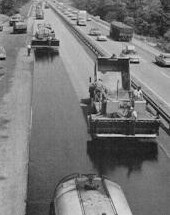
Resurfacing the Turnpike
in the 1950s, as the original
pavement began wearing
out. (PTC)
As the work on the tunnel situation was going on, the commission looked at the strain the interchanges were under, as many had not been enlarged since the highway opened in 1940. In October 1963, a $1.6 million construction project to replace the New Stanton Interchange began. The old interchange which required drivers to make left turns across traffic both within the layout and onto US 119 caused relentless traffic jams. On November 12, 1964, the new interchange opened with connections to I-70 and US 119, and became the first to be replaced, not just expanded.
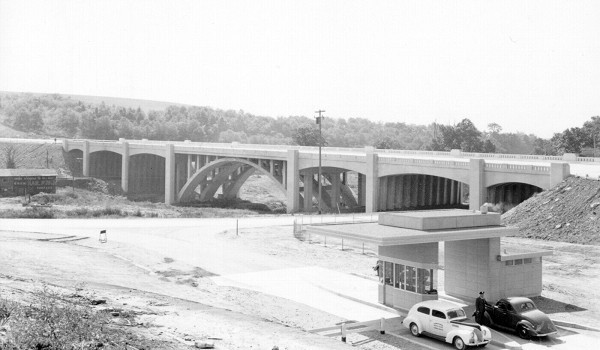
The original layout of the New Stanton Interchange
after the Turnpike first opened. Quite
a drastic change from the current interchange. (Sidney Koch)
New Stanton was not the only interchange where capacity was increased. The Gateway Interchange had three more lanes added to bring its total to 11, the Pittsburgh Interchange's increased to 10 lanes, and a new Harrisburg East plaza was built to provide direct access to Interstate 283 and PA 283. All three projects cost more than $3.2 million and were completed in 1969.
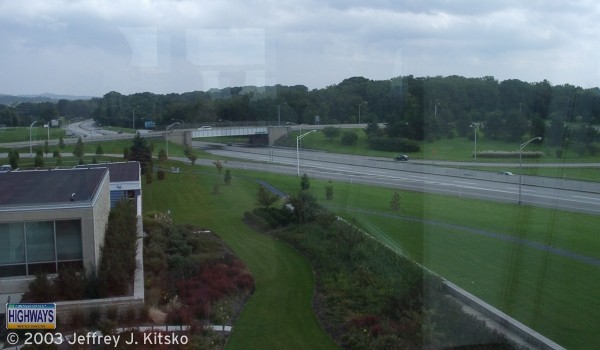
The Harrisburg East Interchange as seen from the
PTC headquarters.
With the new Rays Hill-Sideling Hill bypass construction also involved a new Breezewood Interchange. The $3.1 million project increased the number of lanes from four to ten, to ease traffic using new Interstate 70. Part of the old highway became the new access highway to US 30 and the town.
Another interchange to be replaced was the Exit 286/Reading-Lancaster, which cost $2.7 million. The reason for the new configuration was that US 222 was being upgraded to an expressway on a new alignment east of the original interchange. Most of the busiest interchanges in the system were rebuilt, if not replaced, or enlarged with the addition of more lanes as traffic counts grew. A good example of this was the Perry Highway Interchange, now Cranberry, was enlarged because of the opening of Interstate 79.
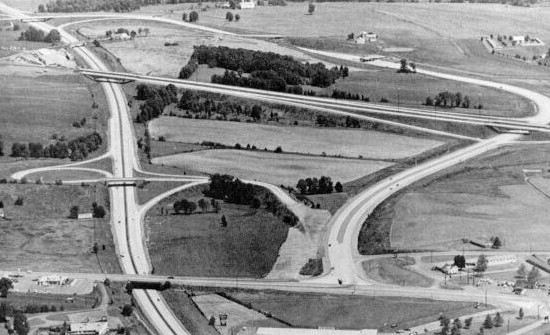
New interchange layout for US 222. (Pennsylvania Turnpike
Commission)
If the rebuilding of interchanges, building parallel tunnels, and bypassing tunnels was not enough, the commission decided on an even greater task. As the suburbs of Philadelphia began to grow, so did the traffic on the Turnpike through those communities complete with morning and evening rush hours. There needed to be a means of getting people on and off the Turnpike with minimal delays at the toll booths, and one was devised in 1968. In that year the Michael Baker, Jr. Inc., the Turnpike's consulting engineers, conducted a study on the practicality on rebuilding the easternmost 47 miles of the mainline from the Morgantown Interchange to the Delaware River Bridge. The conclusion amounted to a $386 million price tag, which was a little hard for the PTC to swallow even with the expected toll revenue. Therefore, the commission and engineers looked at scaling back the plans to $14 million to convert the ticket system to a pay as you go system. Soon, a consultant report came out which stated the project was "assigned the highest priority by the commission and will be completed as soon as practical."
A project of a lesser scale was also taking place during the mid to late 60s. As earlier mentioned, the Turnpike used to have a grass median and no guide rail to prevent cars from crossing into oncoming traffic. With more traffic using the Turnpike, the danger of more accidents like that increased. So the commission decided to pave over the median and place a steel guardrail down the middle which was finished in 1965 on the mainline, and on April 14, 1969 on the Northeast Extension.
In 1965, the 25th anniversary
of the opening, the New York Times ran a story on the highway and commented
on the fact that the toll rate had never increased since 1940. Other states
such as Connecticut, Massachusetts, New York and Ohio, whose toll highways had
opened after the Turnpike, had to raise rates. Unfortunately, inflation caught
up with the highway and on September 1, 1969, the PTC raised the passenger-car
rate from 1 cent/mile to 1.9 cents/mile which was the first increase in 29
years of operation.
The 1970s found the commission finishing projects and looking to new ones. The most important project was the tunnel bypass program. The original Tuscarora Mountain Tunnel had just reopened in October 1970 after being refurbished. The final steps in the process, the reopening of the refurbished Kittatinny Mountain and Blue Mountain Tunnels, took place on March 18, 1971. Four twin tunnels had replaced the original seven two lane tunnels, and for the first time since the highway opened a traveler would not have to squeeze into a single lane to go through a tunnel.
To see what became of the bypassed tunnels, see the Pennsylvania Turnpike's Abandoned Sections page.
TUNNELS BEFORE BYPASSING/TWINNING |
|
 |
The
eastern approach to the Allegheny Mountain Tunnel. (Sidney Koch) |
 |
The
eastern portal of the Allegheny Mountain Tunnel. (Sidney Koch) |
 |
The
eastern portal of the Rays Hill Tunnel. (Sidney Koch) |
 |
The
eastern portal of the Blue Mountain Tunnel. (Sidney Koch) |
 |
The
eastern portal of the Kittatinny Mountain Tunnel. (Sidney Koch) |
 |
The
eastern approach to the Tuscarora Mountain Tunnel. (Sidney Koch) |
 |
The
eastern portal of the Tuscarora Mountain Tunnel. (Sidney Koch) |
 |
The
eastern portal of the Sideling Hill Tunnel. (Sidney Koch) |
A fly landed in the PTC's "ointment" on August 26, 1970 when Interstate 80 opened to traffic from New Jersey to Ohio. The Turnpike needed to modernize to stay competitive with its new free route. Even seasoned traffic specialists couldn't accurately predict the effect that the opening would have on revenue. One study stated that it would cut revenue by $12 million a year, at a time when the highway's annual revenue was more than $70 million. It also said that vehicles would drop from 53 million to 49 million vehicles, but it exceeded that mark by five million in the fiscal year 1971-72.
With the two-lane tunnels either bypassed or "twinned" on the main line, attention turned to the Northeast Extension's Lehigh Tunnel. A 1970 engineer study recommended construction of a parallel two lane tunnel with a cost of $14 million, even after several alternate routes around the mountain had been considered. The study had shown that a bypass would cost $14 to $47 million and add six to eight miles to the system. The Turnpike Commission chose the tunnel option.
These plans were a mere drop in the bucket compared to the greatest proposals of all, rivaling even the construction of the original Turnpike. The "Engineering Report on Turnpike Improvements 1970-1990" envisioned a project that would add four more lanes to the current right of way of the original Turnpike. The $1.1 billion project would create four separate roadways, split by direction and vehicle: two highways in both directions, one for cars and another for trucks. The "Dual-Dual" design would require a 400 foot right of way, with a median of 64 feet between the car and truck lanes in the same direction and a minimum of 80 feet between the eastbound and westbound lanes. Ten miles of this highway would cost as much as the original 160-mile-long Turnpike had cost in 1940. This "mega-Turnpike" would have an 80 mile per hour design speed, holographic road signs, and an electronic icy-road warning system. From Irwin to the Allegheny Tunnel and from Carlisle to the Blue Mountain Tunnel, the Turnpike would utilize the original highway, with two to five mile bypasses here and there to straighten out the alignment, new interchanges at Bedford and Donegal, and the Midway service plaza would be closed and a new one constructed five miles to the east. At the tunnels, the new highway would traverse bypasses, or more parallel tunnels. The most striking of this project would have been the abandonment of the eight mile climb to the Allegheny Tunnel. The highway would be routed over nearby ridge tops. Cars would take a bypass over the mountain, while trucks would still utilize the tunnel. Finally, the proposal stated that a 10 lane roadway would be needed for the New Stanton to Breezewood corridor. The report also offered a $356 million compromise plan to upgrade the most heavily used section to eight lanes and a design speed of 70 miles per hour. The report admitted that the improvements were "principally non-revenue producing, although they must be made to meet the present and future needs of the system."

The eight lane "super-turnpike" conceptual drawing.
(Pennsylvania Turnpike Commission)
Unions were introduced to the Turnpike when new legislation went into effect. By early 1972, the Teamsters Union became the bargaining agent for both field and central office employees. In 1972, the commissioner's consulting engineer complemented both sides on the "transition from a non-union to a union facility with no interruption in service to the Turnpike patron. The job protection provided to the Turnpike employee is a major achievement and benefit to both sides. An employee no longer must worry about his position during election years and the commission will retain (staff) in whom time and money have been invested for training." In nearly 50 years of union representation, there has never been a work stoppage or strike.
It wasn't I-80 that claimed a significant drop in usage, it was the first Arab oil embargo of 1973-74. Many motorists did not want to be stranded without an open gas station nearby, so many opted to stay home. Vehicle volume dropped from 57 million in 1973 to 55 million in 1974 and 1975. Not until 1976 did the total rise back to 57 million. During this time period, a federally mandated speed limit of 55 was imposed, and was enforced on the Turnpike beginning on December 2, 1973.
The Turnpike continued to see improvements, although not to the extreme of the ten lane highway envisioned in the 1970-1990 plan. On April 10, 1974, the new Reading-Lancaster Interchange opened.
On August 1, 1978, the PTC decided to increase passenger car toll rates from 1.9 cents a mile to 2.2 cents a mile. With the fuel embargo easing, the commission also looked to construct truck climbing lanes at three locations: the east approach to the Allegheny Tunnel, the Jacobs Creek area west of Donegal, and the Indian Creek area west of the Laurel Hill bypass. Work began just as the second oil crisis hit the United States. Traffic dropped from a then record of 66 million vehicles in 1979 to 62 million in 1980. The toll increase had helped to keep revenue steady.
Pennsylvania was cast into the national spotlight in March 1979, when an accident occurred at the Three Mile Island Nuclear Power Plant only five miles south of the Susquehanna River Bridge. The accident began at 4 AM on March 28, when a huge jet of steam spurted out of TMI-2's reactor building. The reactor had just come online in December 1978, and was the same design as the reactors of the Shippingport Nuclear Power Plant near Beaver. The problem was a loss of coolant from a worker shutting off both auxiliary feedwater valves at once. Upon a call to the Nuclear Regulatory Commission at 8:45 AM that day, a team of inspectors from the King of Prussia office sped down the Turnpike to Harrisburg, van lights flashing. On March 29, radioactive gas was vented to the surrounding area at 7:35 AM. Upon the release, Governor Richard Thornburgh warned the populace to stay indoors and added, "I am advising pregnant women and preschool-age children to leave the area within a five-mile radius of the Three Mile Island facility until further notice. We have also ordered the closing of any schools within this area. I repeat that this and other contingency measures are based on my belief that an excess of caution is best. Current readings are no higher than they were yesterday." During this time, a hydrogen bubble formed in the containment building and had to be vented as well, and was which reduced its size by half by April 2 of what is was on Friday. On April 9, Thornburgh lifted the advisory he announced on March 30, and the crisis was over with only a partial meltdown of the reactor's core. For more, see the Three Mile Island page.
Before the decade, much like disco,
came to an end, the Turnpike showed up in pop music. A rock band out
of Harrisburg named themselves "The Pennsylvania Turnpike." Later,
radio stations began to play a country song entitled "Pennsylvania Turnpike,
I Love You." It was written by Vaughn Horton, and recorded by a group
called Dick Todd and the Appalachian Wildcats.
Ah, the 1980s, who can forget: Pac-Man Fever, Trickle Down Economics, Rubix Cube, big hair, and the music that lives on in commercials. Or when that new channel called MTV came on and showed something called "music videos" all day. Well, just as times changed in society, they also changed on the Pennsylvania Turnpike. Gone the way of bell bottoms and eight-track tapes also went the familiar Howard Johnson's restaurants that were fixtures at the service plazas since the Turnpike opened. The 1980s were a time when people had to eat and eat quickly. Some of the plazas offered a fast food and a sit-down restaurant. Drive thru windows were added at some locations. Among the names that began to appear were: Arby's, Burger King, Hardee's, McDonald's, Popeye's and Roy Roger's. More extensive menus were introduced at Bob's Big Boy, King's, and Sbarro.
While the choices at service plazas were increasing, the number of ones along the Turnpike was decreasing. In 1980, the PTC shut down the Denver, Mechanicsburg, and Pleasant Valley Service Plazas. All three were located on the westbound side just west of the Reading Interchange, west of the Gettysburg Pike Interchange, and between the Irwin and Pittsburgh Interchanges respectively. Path Valley Service Plaza, located on the eastbound side east of the Tuscarora Mountain Tunnel, was closed in the early 1980s.
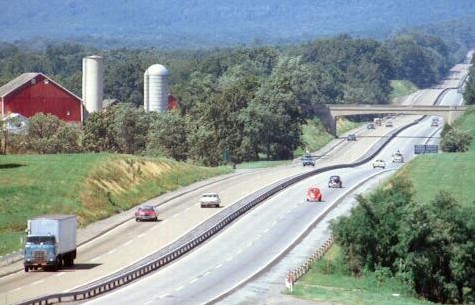
The 12-mile straightaway east of the Blue Mountain Tunnel.
(Pennsylvania Turnpike Commission)
Improvements were also being made to the highway itself. Truck climbing lanes were added at three locations and were completed on December 2, 1981. The largest of these was located at the the eastern approach to the Allegheny Tunnel, which involved relocating 2.2 miles of the eastbound lanes. The original four-lane highway was converted into a three lane westbound right-of-way. At the same time, a two-lane eastbound right of way was constructed a short distance away. This project along with renovating and expanding the Irwin, New Stanton, Donegal, Somerset, and Carlisle Interchanges cost $70 million.
The next improvement came to the toll collection system. Studies began in 1982 on a new system that would utilize a smaller two by five inch ticket, replacing the old three by seven inch tickets, and be computerized. The system went into effect on July 22, 1987. The tickets have a magnetic strip that is encoded with fare and other information, and are dispensed automatically when entering a toll plaza. The system also weighs trucks entering and leaving and calculates a fare through a terminal in the booth how much toll is owed.
Another improvement came in the introduction of a system of call boxes. In December of 1988, call boxes were installed at every mile between the New Stanton Interchange and the eastern portal of the Allegheny Mountain Tunnel. These can provide service, police, or medical help with the push of one of four buttons. The system was extended to the western portal of the Kittatinny Mountain Tunnel on the mainline, the entire Northeast Extension, and the Mon-Fayette Expressway between US 40 and I-70 in 1990. The system expanded to include the entire Turnpike System on November 22, 1991. Unlike on Interstate 81, where call boxes were removed, there are no plans to remove them even with the proliferation of cell phones and the system costing $200,000 yearly to operate.
Other changes took place on traveled parts of the Turnpike. In 1987, the PTC approved the use of the abandoned 10.3 mile right-of-way that was bypassed in the 1960s. This section includes the Ray's Hill and Sideling Hill Tunnels, which has become the topic of some of the web pages listed below. The section is used for the Safety Testing And Research (STAR) facility. Sideling Hill Tunnel is used for nighttime reflectivity tests, and elsewhere a portion of the shoulder is used to test SNAP (Sonic Nap Alert Pattern), a indented rumble strip that runs along the side of the roadway to alert people when they are driving off the lane.
More recently, this section has been used to test sign reflectivity and sizing for under the direction of the Federal Highway Administration inside and outside of the Sideling Hill Tunnel and testing the effectiveness of traffic barriers on curves, curbs, and slopes over hillsides. The western end, behind the motels in Breezewood, has been utilized by the FHWA and the National Traffic Safety Board to conduct accident investigation training with low speed skid tests utilizing tractor-trailers. An auto manufacturer has conducted heatlamp tests inside and outside of the tunnels. Lead paint removal technology was tested on the underside of one of the overpasses, and the FHWA a laser-based vehicle control system. Troop T, the Pennsylvania State Police detachment that patrols the Turnpike, tested a "road nail" system that can be stretched across the highway to stop a speeding vehicle and then pulled away to let the police cruisers by safely. The National Automated Highway System Consortium (NAHSC) has been offered the highway to test and demonstrate a prototype of future highway technology which is now available under the "Intelligent Vehicle Initiative," a USDOT program set up to speed the deployment of technology to improve safety. Even the Pennsylvania Film Bureau is getting into the act, by offering the alignment to Hollywood for movie production. So far, the STAR facility has only been used in a truck suspension video to advertise their product's reliability on a rough highway. As for the Laurel Hill Tunnel, well, it has taken a less dramatic role. The Turnpike maintenance department uses it to store road salt and other materials.
The most significant change in the 1980s came with the passage and enactment of Act 61. This law enabled a new era in construction and expansion within the Pennsylvania Turnpike System. With this new act, the PTC could pursue new projects, some of which had been on planning boards for years. Some of them held up by financial and/or political factors, others that were to be incorporated into the state highway system. The bill was passed in September 1985 and a new $807 million bond was created, which spurred a rise in toll. Passenger car rates rose from 2.2 cents per mile to 3.1 cents per mile.
TURNPIKE EXPANSION (ACT 61) PROJECTS |
||
| Project | Current Status (Ending) | Next Phase (Ending) |
| Fort
Washington, Willow Grove, and Philadelphia Interchange Reconstruction |
Completed (1986) | |
| Six-Lane Widening | Completed (1987) | |
| Beaver Valley Climbing Lane | Completed (1990) | |
| Lehigh Tunnel Number 2 | Completed (1991) | |
| Downingtown
Interchange Expansion |
Completed (1991) | |
| Keyser Avenue Interchange | Completed (1992) | |
| Mid-County Interchange | Completed (1992) | |
| Beaver Valley Expressway | Completed (1992) | |
| Amos K. Hutchinson Bypass | Completed (1993) | |
| New Cumberland Army Depot Interchange |
Discontinued |
|
| Mon-Fayette Expressway | Construction (20??) | Completion (20??) |
| I-95 Interchange | Construction (20??) | Completion (20??) |
| Southern Beltway | Construction (20??) | Completion (20??) |
Consult the Act 61 Map to see where in the state these projects were/are located. For more on the extensions to the system or ones that were planned, see the Pennsylvania Turnpike section of the Pennsylvania Consolidated Statutes page.
With the rising traffic volume, these projects became even more important. From 1980 when the volume was 63 million vehicles to 97.4 million vehicles by 1989. The average daily traffic count of 270,000 in 1989 was 75 times the level predicted for the original Middlesex to Irwin section before it opened. The milestone of traffic volume was reached on October 31, 1989 when William Snow was chosen as the Turnpike's two billionth traveler. Snow, a West Virginia motorist, entered the Turnpike at Irwin bound for the Pittsburgh Interchange. PTC officials gave him gifts, tourist attraction passes and vacation vouchers. Observers pointed out that officials could not waive his 40 cent toll.
Since the popularity of the Poconos had increased, so did the traffic that resulted in 22,000 vehicles a day during August: the busiest time of the year. In 1988, a contract to widen the Lehigh Tunnel on the Northeast Extension was awarded for $37 million. On February 14, 1989, ground was broken on the second tunnel. A new method to constructing this tunnel was implemented. The other tunnels were constructed by blasting rock loose, then clearing the debris and erecting a steel superstructure inside the tunnel which was repeated many times until the tunnel was completed. The new technique is called the New Austrian Tunnel Method (NATM), and this was the first highway project in the United States to use NATM. It has been used in Europe since the 1950s, it had been utilized in two light rail projects: the Mount Lebanon Transit Tunnels in Pittsburgh and Washington Metro system. With the technique, after each blasting of rock, the ceiling and sides are stabilized by being sprayed by shotcrete. The 4,380-foot-long tunnel was bored 94 feet west of the existing tube and was "holed through" on June 12, 1990. The men, working three shifts, 24 hours a day, six days a week had tunneled 3,550 feet through the north side of the Blue Mountain and and 675 feet through the south side. It opened to traffic in November 1991, and eliminated the last two lane section of the Turnpike. When it opened, the original tube was closed for refurbishing.
|
|
|
|
In late 1989, ground was broken on the Mid-County Interchange in Plymouth Township, Montgomery County. This project included the largest contract awarded by the Pennsylvania Turnpike Commission. The interchange is the largest in the system and the first additional interchange on the mainline to be constructed since completion of the Scranton Interchange, now named Clarks Summit, on the Northeast Extension in 1957. The interchange has the largest toll plaza with 17 lanes for entering and exiting traffic and eight ramps comprising 4.4 miles. The Mid-County and Norristown Interchanges are connected via a fiber optic cable which permits data sharing between the toll plazas and the main office in Harrisburg.
A $55 million general construction contract was awarded to the Hull Corporation of Syracuse, New York in late 1989. This included construction of the toll plaza, utility building, roadway, structures, signing, and lighting.
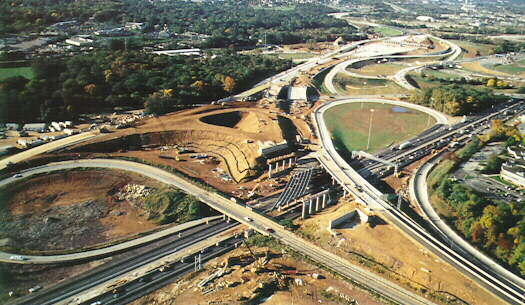
Mid-County Interchange under construction.
The old Northeast Extension
interchange bridge
is in the foreground. (Pennsylvania Turnpike Commission)
In 1990, the PTC awarded contracts totaling $131,000 to the Hull Corporation for heating, ventilation, and air conditioning. Thomas M. Durkin and Sons' contracted to handle wetland replacement totaling $316,097.
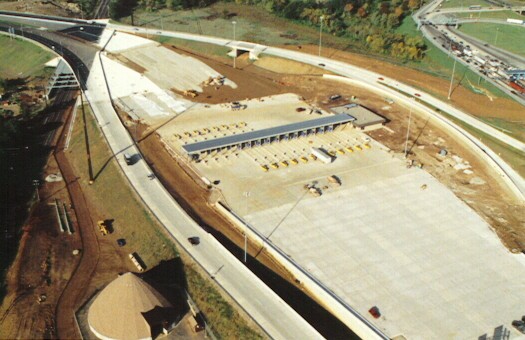 The new 17 lane toll plaza. The ramps on the edges of the picture are for the Germantown Pike interchange. (Pennsylvania Turnpike Commission) |
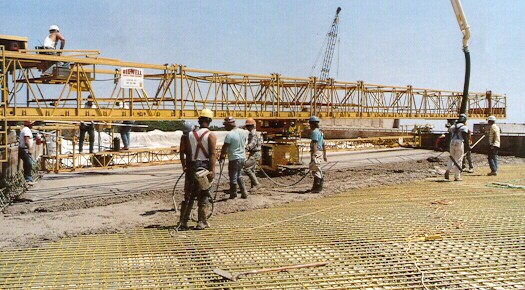 Workers pouring concrete for the deck of the new southbound bridge. (Pennsylvania Turnpike Commission) |
Since the construction took place in a highly developed area of suburban Philadelphia where there are many active roadways, maintaining a smooth traffic flow posed a challenge. To prevent problems, the project was divided into phases and stages. The purposes of this was to maintain at least four lanes of traffic on the mainline Turnpike and to provide access to the Northeast Extension while the ramps are under construction. Solution cavities posed an even greater problem to the construction. These are formed when groundwater has worn away earth between limestone rocks, thus creating an underground cavern. To guarantee that the bridge supports at the south end of the culvert for the Plymouth Creek sat on firm ground, an addition $400,000 was needed. This paid for extra excavation and concrete work. A concrete grout mixture was pumped underneath and around the bottom of the bridge pilings required an additional $350,000. On December 15, 1992, the first interchange on the Turnpike to have "fly over" ramps opened to traffic.
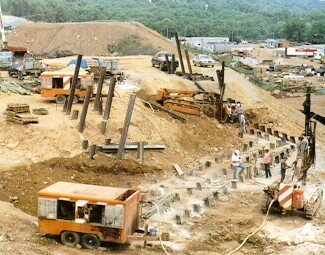
Grout being pumped into underground voids.
(Pennsylvania Turnpike Commission)
Tandem toll booths (two toll booths on a single lane at an interchange) were implemented at the Valley Forge Interchange in 1988 and Willow Grove Interchange in 1989. With two collectors on a lane, traffic can move through the toll plaza more quickly.
The first Act 61 contract was a $120 million project to widen the main line near Philadelphia to six lanes. On March 10, 1986, work began on a 17 mile stretch between the Philadelphia Interchange and the Northeast Extension interchange. The project was completed on November 23, 1987; however, improvements to the Fort Washington, Willow Grove, and Philadelphia Interchanges preceded the widening.
Work also began on an eastbound
truck climbing lane on the western end of the Turnpike. It was constructed
just east of the Beaver River bridge. Construction began in 1989 and
the lane opened in 1992. Another project in Western Pennsylvania that
began (again) was on the Mon-Fayette Expressway, or as it is known, PA Turnpike
43. PennDOT began construction on sections near California, but stopped
work because of lack of funds. On March 26, 1987 Governor Robert Casey
committed $40 million to complete the broken sections. On June 8, 1988, ground
was broken and construction resumed in the corridor after 12 years.
The section from I-70 to US 40 opened on October 12, 1990 and the section
from near the West Virginia state line to US 119 opened on March 1, 2000. Other
sections are under construction or proposed.

Just as Howard Johnson's disappeared from the service plazas, so did Exxon fuels in April 1990. Standard Oil, the predecessor to Exxon, had a hand in gasoline sales on the Turnpike since it opened in 1940. Every service plaza from New Stanton to Plainfield switched to Gulf, and eventually all 22 to Sunoco in 1993. Credit card-activated pumps, as well as fax machines, ATMs, and informational lodging boards which allow travelers to make reservations were installed at the service plazas. Compressed natural gas and quick-charging battery stations for electric cars was planned to be added at the King of Prussia and South Somerset service plazas in 1994, but the PTC deemed public interest to be too low to justify the cost.
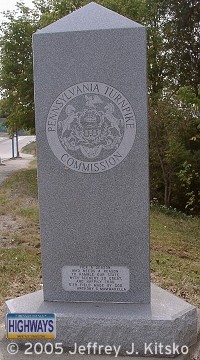 |
Granite milepost at the Irwin Interchange that was placed in 1990 to signify the original western terminus when the Turnpike opened 50 years before. The inscription from Anthony S. Mammarella reads, "Pick a season, who needs a reason, to ramble our state, with scenery so great, and happily trod, o'er field made by God." |
As the Turnpike neared its 50th birthday, ground breaking for extensions to the highway began. The first was for the James E. Ross Highway which took place on June 10, 1990 and was the first Turnpike project in Western Pennsylvania since the Western Extension. PA Turnpike 60, as it is numbered, opened on November 20, 1992.
 With the completion of the call box
system across the entire system in 1991, another feature was added that
incorporated a growing technology. On July 4, 1990, the PTC introduced the
*11 emergency cellular phone number. By calling the number, travelers have
access to the same services they can receive by using a call box.
With the completion of the call box
system across the entire system in 1991, another feature was added that
incorporated a growing technology. On July 4, 1990, the PTC introduced the
*11 emergency cellular phone number. By calling the number, travelers have
access to the same services they can receive by using a call box.
The Keyser Avenue Interchange was added in the early 1990s. Construction began in February 1991 on the interchange that served as the final exit on the Northeast Extension while the Wyoming Valley mainline toll plaza was built and the Scranton Interchange underwent reconstruction. The interchange was designed by Gannett Flemming, Inc. of Camp Hill and American Asphalt Paving of Shavertown performed the construction while Wyoming Sand and Stone supplied materials for the project. The interchange completely opened in 1992.
As mentioned above, work also began on the mainline north of the Wyoming Valley Interchange. An $11 million project began on March 19, 1991 with the demolition of the old Wyoming Valley Interchange and construction of a seven lane mainline plaza two and a quarter miles south. This is now where the ticket system ends, because from that point north the highway is a coin drop system as on the toll highways in Southwest Pennsylvania. In November 1992, this section of the Turnpike reopened to traffic.
The winter of 1993 played havoc with the entire highway system of Pennsylvania, not just the Turnpike. The weekend of March 13-14, 1993, the "storm of the century" hit the Commonwealth and, for the first time in decades severe weather managed to close the the highway. Toll collector Don Butler spent 39 hours at the Harrisburg East Toll Plaza. National Guard Humvees rescued stranded motorists on the eastern approach to the Allegheny Mountain Tunnel, while on the western side snow drifts were as deep as 20 feet in some places.
Those with a lead foot received a welcomed gift on July 13, 1995, when Pennsylvania raised the maximum speed limit on 1,440 miles of expressways including most of the Turnpike, as well as the Mon-Fayette Expressway, James E. Ross Highway, and Amos K. Hutchinson Bypass.
History was made again on the Turnpike on July 18, 1995 when the first electric vehicle completed a drive from end to end. West Penn Power, now Allegheny Power, sponsored the Ford Ecostar van that was driven by State Representative Herman Mihalich of Westmoreland County. He began the trip a day earlier at the Gateway Toll Plaza at the Ohio state line and finished at the Delaware River. "I'm delighted to have participated in a bit of the history and lore of the turnpike," Mihalich said, noting that his wife's great-great-great grandfather once operated a stagecoach line between Philadelphia and Pittsburgh, close to the current Turnpike route. He added, "It's becoming a family tradition." Mihalich sponsored legislation in 1991 to eliminate a portion of the sales tax on electric vehicles as well as legislation to waive the annual registration fee to promote their sale. West Penn Power president Jay Pifer joined Mihalich for the first leg of the trip from Ohio to the PTC headquarters in Harrisburg.
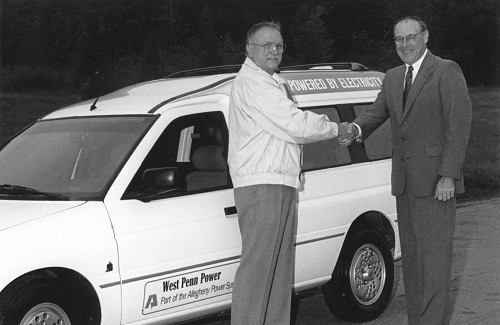
Representative Herman Mihalich and West Penn Power
President Jay
Pifer with the Ford Ecostar van in the background. (West Penn Power)
In 1996, the Turnpike Commission lobbied to have the Interstate 476 designation extended up the Northeast Extension to Scranton and the change officially occurred on November 1 of that year.
Construction on another extension, PA Turnpike 66, began in 1990. The first section of the highway, from I-70/I-76/US 119 to US 30 opened on July 13, 1993. The rest of the highway opened on December 9, 1993. The PTC held an open house, which I attended, where you could walk down the highway while some chose to ride bicycles. The Southern Beltway, another extension near Pittsburgh, is partially under construction. It will be a highway from the Mon-Fayette Expressway to the Pittsburgh International Airport.
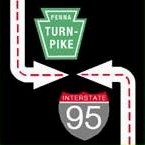 Many
people ask why the Turnpike does not connect to some major Interstates such as
I-95. Well, the PTC is coming around on that topic. Until the late 1960s, I-95 followed the US
13 alignment in the area. It would have provided a direct connection to
the Turnpike, but because of environmental reasons the Interstate could not be
built north of the Turnpike. After cancellation of the Somerset Freeway in
New Jersey, the Turnpike Commission was tasked in 1985 with creating a
connector. The original plan would have taken 150 homes and cut through
Delhaas Woods to build the connecting ramps, but the plan had changed by 1999 to
only require the taking of 10 homes and sparing the woods entirely.
Many
people ask why the Turnpike does not connect to some major Interstates such as
I-95. Well, the PTC is coming around on that topic. Until the late 1960s, I-95 followed the US
13 alignment in the area. It would have provided a direct connection to
the Turnpike, but because of environmental reasons the Interstate could not be
built north of the Turnpike. After cancellation of the Somerset Freeway in
New Jersey, the Turnpike Commission was tasked in 1985 with creating a
connector. The original plan would have taken 150 homes and cut through
Delhaas Woods to build the connecting ramps, but the plan had changed by 1999 to
only require the taking of 10 homes and sparing the woods entirely.
Stage One involved building a high-speed interchange between the Pennsylvania Turnpike and Interstate 95, a new mainline toll plaza, and widening the Turnpike from Exit 351 to the Delaware River. Stage Two will involve constructing a parallel span across the Delaware River south of the existing span. The following were the plans for the new toll plaza, interchange, and bridge:
|
|
|
|
|
|
On January 6, 2004, the US Department of Transportation approved the environmental impact study. "Late 2007" was the "optimistic forecast" for groundbreaking for the first part, a new toll plaza, said PTC spokeswoman Christina Hampton after the announcement was made. The North Neshaminy Service Plaza was closed on May 12, 2010 and replacement of overpasses along I-276 at Bristol-Oxford Valley Road and Galloway Road began October 25 and November 15, 2010 respectively as part of this project. The new $9.7 million overpasses opened to traffic on November 4, 2011.
An unusual financing scheme to complete the interchange came to light in April 2013. Foreign investors, primarily from China, would infuse the project with $200 million, and in turn, they would get green cards for themselves and their families. The deal involves creating a new limited partnership called the Delaware Valley Regional Center Pennsylvania Turnpike L.P., with an office in Berwyn, that would have to be approved as a US Citizenship and Immigration Service designated "regional center" to recruit foreign investors with which to provide the Turnpike Commission the loan. On April 26, the PTC signed a $200 million loan agreement with the limited partnership. Federal law permits the dealmakers to go immediately to China, or elsewhere, to begin recruiting investors, but they can not accept funds until approval. Despite some success around the country with these type of partnerships, the Immigrant Investor Program has drawn criticism for lax oversight and dubious projects that have not produced domestic jobs nor permanent green cards for foreign investors.
PTC CEO Mark Compton joined Governor Tom Corbett and Lieutenant Governor Cawley as well as federal, state, and local officials at the Trevose Maintenance Facility, where the mainline toll plaza was built, in Bensalem on July 30, 2013 to officially kickoff the start of the $500 million Stage 1 of the project. "We’re here to commemorate the beginning of a critical infrastructure project that will undoubtedly improve the quality of life for residents and commuters in the surrounding area," said Turnpike Chief Executive Officer Mark Compton. "Many also consider the Turnpike/I-95 link to be a central component for the continued economic growth and competitiveness of this region."
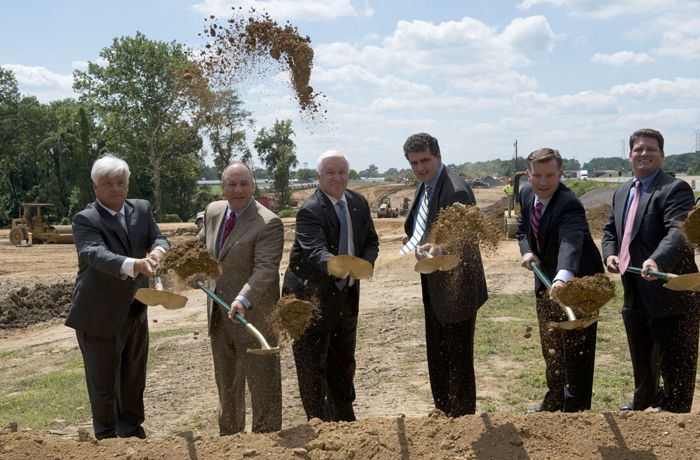
Governor Tom Corbett is joined by local and state officials for the
groundbreaking
(Pennsylvania Commonwealth Media Services)
Construction of the new Open Road Tolling gantry for westbound traffic, utilizing high-speed E-ZPass as well as PA Turnpike TOLL BY PLATE equipment for photographing license plates at highway speed, at the Delaware River Bridge began in June 2013. On January 3, 2016, the new Open Road Tolling facility became the first on the system to be equipped for toll-by-plate technology. Tolls were suspended at the former Delaware River Bridge Toll Plaza as well as at Exit 358, with demolition of both toll plazas occurring during the summer of 2016. Work began in September 2014 on reconstructing and widening the Turnpike from west of the Interstate 95 overpass to west of the Delaware River Bridge Toll Plaza. Also included will be installation of stormwater-management facilities, erosion and sedimentation control measures, and the construction of sound and retaining walls. Roadway improvements to Durham Road and New Rogers Road will also take place. Work on this phase concluded on September 21, 2018 with a ribbon-cutting ceremony at the new interchange, with the ramps connecting Interstate 95 and the Turnpike opening on September 24. The Interstate 95 designation was then changed to cross the Delaware River Bridge into New Jersey and the remainder of the highway to the Scudder Falls Bridge became Interstate 295. The ramps marked the completion of the original Interstate System plan, and marked the first time drivers utilizing Interstate 95 between New York and Philadelphia could do so unimpeded. Project website: http://www.paturnpikei95.com/..
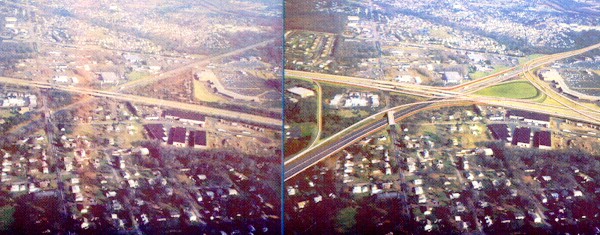
Current I-276/I-95 crossing at the left and
conceptual drawing of the future I-276/I-95
interchange. (Pennsylvania Turnpike Commission)
An unusual financing scheme to complete the interchange came to light in April 2013. Foreign investors, primarily from China, would infuse the project with $200 million, and in turn, they would get green cards for themselves and their families. The deal involves creating a new limited partnership called the Delaware Valley Regional Center Pennsylvania Turnpike L.P., with an office in Berwyn, that would have to be approved as a US Citizenship and Immigration Service designated "regional center" to recruit foreign investors with which to provide the Turnpike Commission the loan. On April 26, the PTC signed a $200 million loan agreement with the limited partnership. Federal law permits the dealmakers to go immediately to China, or elsewhere, to begin recruiting investors, but they can not accept funds until approval. Despite some success around the country with these type of partnerships, the Immigrant Investor Program has drawn criticism for lax oversight and dubious projects that have not produced domestic jobs nor permanent green cards for foreign investors.
One of the other major Interstate connections that is discussed a lot is the Interstate 70 interchange at Breezewood. It is one of the rare places on the Interstate System that you encounter a traffic signal on the highway itself. Two provisions of Section 113 of the Federal-Aid Highway Act of 1956 proved unlucky in regards to a direct connection. Section 113(b) stated that funds could be used for approaches to any tolled alignment as long as a toll-free highway option was available to drivers. Section 113(c) stated that funds could be used to build an interchange between a free Interstate and an toll Interstate, as long as the state highway agency, toll authority, and Bureau of Public Roads entered into an agreement to stop collecting tolls once the bonds were retired. The Turnpike Commission showed no desire to stop collecting tolls, and not only decided to balk at using the Federal-aid funds for the connection, but decided against using its own revenue for an interchange. During a Special Subcommittee on the Federal-Aid Highway Program hearing on May 10, 1966, Franklin V. Summers, PTC's Director of Operations said, "We are willing to share whatever we legally can, of course, in making such direct connections; and we are doing so on some of them. However, where new interchanges would not afford an increase, great increase in revenue, we do not feel that these matters should be thrust upon the turnpike commission." He pointed out that the PTC was concerned at facing possible declining revenues when Interstate 80 would be completed across the middle of the State. With the Turnpike Commission unwilling to use its own money for an interchange, the Department of Highways used the Federal-aid funds to extend I-70 north from the Turnpike to US 30 which followed the stipulation of Section 113(b). The situation will not be rectified any time soon since the owners of the numerous gas stations, restaurants, and motels that line US 30 said their businesses would be forced to close their doors with an Interstate-Turnpike direct connection. Michael Dawida, a Pittsburgh area state senator, who had been involved in an accident at the intersection, announced his intention on July 26, 1989 to introduce a bill to be put forward in the state senate that would close the gap as well as studying building a direct connection at Interstate 81 in Carlisle. He said at a new conference, "Anyone who has sat in that traffic, waiting five minutes to travel one mile, knows just how frustrating it can be — and how dangerous." PennDOT told Dawida that a direct connection is feasible, and the Turnpike Commission already owns land where it would be constructed. "It's one of those inexplicable things in government where no one has gone and done the logical thing," Dawida said. The reason, as the state senator explained, lies in the political pressure exerted by Breezewood merchants as is in located in the district formerly represented by US Representative Bud Shuster the chair of the House Transportation Committee. State Senate Pro Tempore Robert Jubelier, who represented Breezewood, did not like the idea and felt Dawida should have consulted him before announcing the bill. "Why doesn't he complain about the traffic in the Squirrel Hill Tunnel? My constituents are always complaining about the tie-ups there when they try to get into Pittsburgh," Jubelier said. Senator Dawida eventually dropped his push for a direct interchange. As a "consolation prize," PennDOT changed traffic patterns, upgraded US 30, and improved the traffic signals in a $4.5 million modernization project.
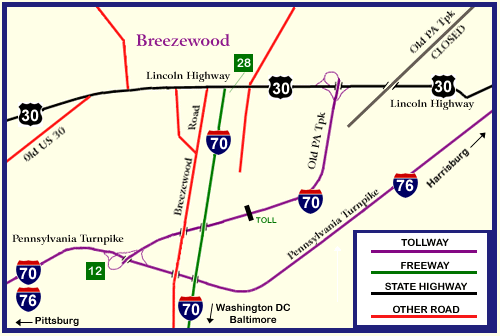
The debacle that is Breezewood. (C. C. Slater)
Rebuilding the original Turnpike began in June 1998 when the first contract for $24 million was awarded. The section was between mileposts 94 and 99 near the Westmoreland/Somerset County line, and it was completed in 2000. Later that year, work began on the sections from mileposts 76 to 85 and mileposts 187 to 197.

Sign at milepost 99 advising
drivers they are entering the first
section to be
rebuilt.
The afternoon of Monday, September 14, 1998 was not what you could call a normal day near milepost 40.1. Turnpike Assistant Maintenance Foreman Guy Jeffrey of the Gibsonia maintenance facility made a shocking discovery at that milepost: a newborn baby girl with the umbilical cord still attached, lying on her back on the shoulder of the westbound lanes. "The closer I got, I knew it was a baby. I got nervous. I said to myself, 'This can't be real.' It scared me. It's still unbelievable that anyone could do this," said Jeffrey. Luckily Donna Miller, a registered nurse, happened by the scene and stopped. They wrapped the baby in a blanket and whisked her to the maintenance facility where a medical helicopter had landed to take her to Pittsburgh's Children's Hospital. The baby was discharged three days later to Children and Youth Services who found her a new home. Miraculously, the infant did not suffer any major internal injuries to her brain or internal organs.
The first phases of the Turnpike's Advanced Traveler Information System (ATIS) went into service in Fall 1998. The system comprises a network of highway advisory radio stations and variable message signs controlled from the Turnpike's headquarters in Harrisburg. Other components to the system included: cameras installed at various interchanges, a traffic flow detection system, a roadway weather information system, a truck rollover alert system, and an overheight detection system. Also, weather stations are slated to be constructed at Laurel Hill in Westmoreland County, a site between the Somerset Interchange and the Allegheny Mountain Tunnel, and on Sideling Hill. A station will also be built on the Northeast Extension north of the Mahoning Valley Interchange. "These weather stations will provide us with real time roadway conditions. This will allow, for example, the rapid deployment of snow removal and salt crews," said Steve Barber, Turnpike Director of Safety and Operations.
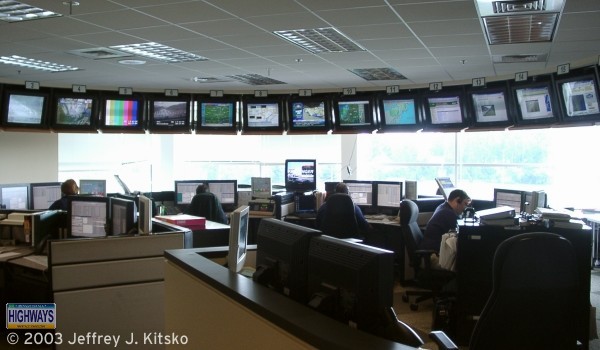 The command center in the PTC headquarters where ATIS information originates. This is where calls from cell phones and call boxes are received. The monitors at the top show feeds from cameras at various locations on the Turnpike, as well as The Weather Channel, weather radars, and traffic information web sites. |
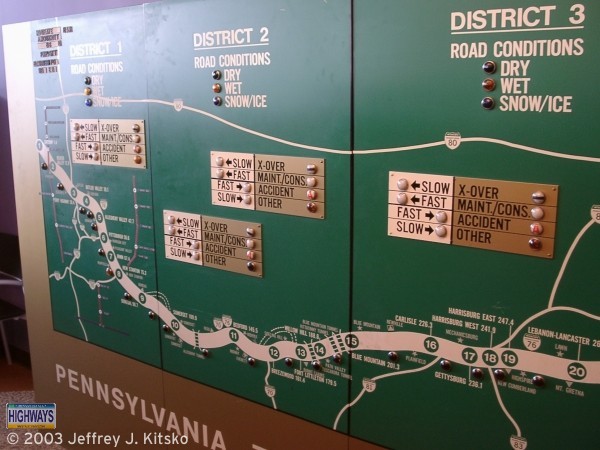 High-tech back in the day, this was what employees used to keep track of conditions along the Turnpike. As you can tell from the western extensions being on it, it hasn't been out of commission long. |
Keep that toll receipt if you travel the Turnpike, it could be worth something. Beginning in early 1999, the PTC began printing coupons on the back of them. Most receipts go to business travelers, so there will be a perforation that separates the travel information and the coupon. Staples signed on as the first advertiser to the program.
When the Turnpike opened back in 1940, it was known as the "tunnel highway." Rightfully so, as travelers had to encounter seven tunnels from Irwin to Carlisle of which three were eliminated in the 1960s and the remaining four twinned. Engineers are now considering the future of the Allegheny Tunnel as the original northern tube is in need of repair; however, this time it is not feasible to close the tunnel down and route traffic through the other one with the traffic volumes of today.
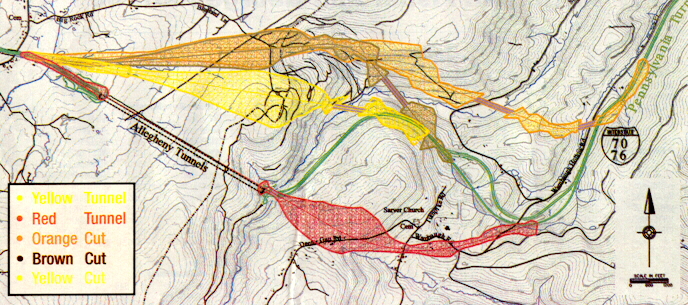
Five Proposed Alignments for the Allegheny Tunnel
Project. (Pennsylvania Turnpike Commission)
Out of the five alignments, the brown one with a tunnel seems to be preferred among hunters, environmentalists, and locals. One of the selling features of the alignments with the tunnels is that it kept the roadway at a lower elevation. This is revealed by noticing that the worst conditions on the system are usually found at the Rays Hill/Sideling Hill bypass where there can be snow, sleet, fog, slippery conditions, etc. when there is fair weather in the nearby lower elevations. According to Neil Raup, Turnpike engineer spearheading this project, the brown alignment would be lower than the current alignment through the Allegheny Tunnel. While first being studied in 1996, shelved, talked again in 2001, shelved, it looks like this project will finally get off the ground when in 2013, a study by L. Robert Kimball of Ebensburg began on solutions for the bottleneck. Six alternatives will be studied, ranging in price from $242 million to $694 million. While updated environmental assessments have been made, conservationists and locals are concerned over impacts to the environment and wildlife as well as to water supplies.
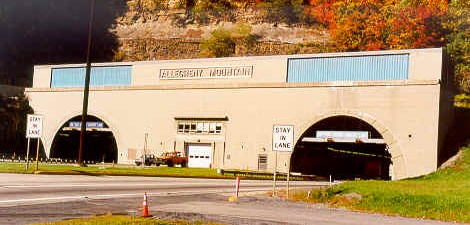
Allegheny Mountain Tunnel (Pennsylvania Turnpike Commission)
In January 1999, the PTC began
a feasibility study on widening the highway from the Valley Forge Interchange
to the Norristown Interchange, and from the Mid-County to Lansdale Interchanges
on the Northeast Extension. Work was already underway to widen the existing bridge
over the Schuylkill River which began in Spring 1997. That $35.6 million
project wrapped up in June
1999. The project on the Northeast Extension is a little more
complicated since the existing median is only four feet wide. Urban
engineers will be brought in to design a plan for the ten mile section from
Mid-County to Lansdale, which includes a slip ramp south of the
interchange.
 Now that we have made it to the 21st Century, some things have changed
and something have not. So we don't have flying cars or robot maids;
however, we still have highway construction in Pennsylvania, especially on the
Turnpike as the rebuilding of the original roadway from Irwin to Carlisle
gets underway. Beginning in the spring of 2000, sections of the highway will
be completely rebuilt. The project will continue for the next 16 years
with new grading, new drainage systems, new pavement, new guide rails, and
a new median as the result. The median will be widened to 18 feet and
a newly designed concrete barrier will occupy the middle. There will be eight-foot-wide shoulders between the barrier and the left lanes, which will allow
easier access for emergency vehicles and traffic to flow in the event of
an accident. An interesting aspect of the reconstruction is that the
original concrete is being recycled to provide a base for the new highway.
A six mile section of newly reconstructed eastbound lanes of the Turnpike
opened to traffic on October 15, 2000 east of New Stanton. The project
finished in 2002. Click here
for a comparison between the cross-section of the original highway and the
rebuilt highway.
Now that we have made it to the 21st Century, some things have changed
and something have not. So we don't have flying cars or robot maids;
however, we still have highway construction in Pennsylvania, especially on the
Turnpike as the rebuilding of the original roadway from Irwin to Carlisle
gets underway. Beginning in the spring of 2000, sections of the highway will
be completely rebuilt. The project will continue for the next 16 years
with new grading, new drainage systems, new pavement, new guide rails, and
a new median as the result. The median will be widened to 18 feet and
a newly designed concrete barrier will occupy the middle. There will be eight-foot-wide shoulders between the barrier and the left lanes, which will allow
easier access for emergency vehicles and traffic to flow in the event of
an accident. An interesting aspect of the reconstruction is that the
original concrete is being recycled to provide a base for the new highway.
A six mile section of newly reconstructed eastbound lanes of the Turnpike
opened to traffic on October 15, 2000 east of New Stanton. The project
finished in 2002. Click here
for a comparison between the cross-section of the original highway and the
rebuilt highway.
It was not construction that brought
traffic to a halt on the Turnpike on April 6, 2000, but massive potholes.
A ten mile section of the highway was closed for more than 18 hours,
creating traffic jams and gridlock in towns such as Mount Pleasant, where vehicles
were rerouted. "Some huge potholes opened up due to soft soil and wet soil
beneath the roadway," said Carl DeFebo, a Turnpike Commission spokesman.
The potholes developed between mileposts 75 and 85. Some of them were
reportedly five to twelve-feet-wide and some were a foot deep. Officials
knew that a closing could come after the Angelo Iafrate Construction Company
of Warren, Michigan, which is overseeing the rebuilding of the Turnpike between
New Stanton and Donegal, discovered the soft soil underneath the the right,
eastbound lane. DeFebo went on to say that the potholes are a result
of seasonal changes and "also due to the age of the road. It's a 60
year old road. We knew problems like this were inevitable. Since the
Turnpike opened it's been graded and paved (when problems occur). This
is the first time we're replacing it from the drainage up. We call
it a total reconstruction."
On May 23, 2000, a fiery crash
occurred at the Gateway Toll Plaza near the Ohio state line. A truck slammed
into the toll plaza and burst into flames; the driver was killed instantly.
State Police do not know why the driver failed to notice the flashing
tollbooth signs and the rumble strips approaching the plaza. Three
toll collectors were injured, and two of the three suffered burns.
Luckily, the three were able to jump clear of the booths before the
truck crashed and exploded.
Still another major accident occurred
on the Turnpike on September 8, 2000. Six miles west of the Donegal Interchange, a tractor-trailer slammed into a traffic jam, resulting in a
17-vehicle pileup within the construction zone. Ten people were injured
in the accident that occurred in the westbound lanes, including one woman
who was flown by helicopter to a Pittsburgh hospital. However, none of the
injuries were considered life-threatening.
The woman flown to Pittsburgh
was Delia Veschi, who was admitted to UPMC Presbyterian in Oakland in fair
condition. She was trapped for 45 minutes in her Dodge Neon, which
was crushed under a tractor-trailer. Firefighters and construction
workers freed her from where she had become wedged in between the seats.
Ms. Veschi managed to escape without any serious injuries. Mount
Pleasant Fire Chief Gerald Lucia said that her crushed car had to be pulled
from underneath the tractor-trailer before the fire crews could extricate her. He said that the construction crews helped to calm her down.
"The construction crewmen really helped calm her. It's a frightening
feeling being beneath that...like you're wrapped with metal around you and
can't move, and you're beneath a truck...you can't explain it," Lucia went
on to say.
The accident happened at 10:57 AM at
milepost 84.4 when a tractor-trailer being driven by Alan S. Warchol
of Bordertown, New Jersey, came around a curve in the highway and plowed into the
rear of a traffic jam in the construction zone. Pennsylvania State
Police said that Warchol and a passenger, James Hunt, escaped without injury. The traffic jam in question was a result of an earlier accident that
occurred at 9:44 AM near the New Stanton service plaza. This was
the 14th in a series of 15 accidents that occurred on the Turnpike in
2000.
With all of the talk about upgrading,
the PTC and the Marriott Corporation are investing over $40 million in upgrades
to the 22 service plazas. This includes parking lot and lighting
improvements, new wastewater treatment facilities, renovating rest rooms
and dining rooms, and new furniture. The largest investment, over $30 million,
went into new parking lots and lighting at the Hickory Run, Plainfield, Blue
Mountain, New Stanton, North and South Midway, North Somerset, Allentown,
Bowmansville, and Zelienople service plazas. Entry and exit lanes were
lengthened, parking lots were enlarged, reconfigured, resurfaced, and new
lighting and new signage was installed. In addition to the dining area
renovations, new eateries were added to some plazas and the Turnpike Commission
will be adding ATMs to all 22 service plazas.
With the implementation of the E-ZPass
system, the PTC was able to open its first two slip ramps at Virginia Drive at
the Fort Washington Office Center Park. The interchange is the first
unmanned exit, and first to be numbered using mileage-based exit numbers, on the
mainline Turnpike, utilizing only the E-ZPass system to charge tolls for
vehicles entering or exiting the westbound Turnpike. Construction of the
ramps began in early 2000. Additional slip ramps are being planned along
the Turnpike near large businesses or corporate parks, to allow drivers to enter
or exit the highway closer to their workplace.
A $7 million improvement project
concluded in the winter of 2000 at the Tuscarora Tunnel. The work included
replacing the old fluorescent fixtures with 2,500 high-pressure sodium
lights. These new lights improve safety, maintenance costs, energy
consumption, and operating costs. Other aspects of the project included
repairs to the ceiling slabs and installation of netting to protect the highway
from falling chips, new piping to correct a continuing groundwater seepage,
and upgrading the tunnel's power distribution system, including four new
diesel-powered generators to replace the old turbines that were the backup power
system.
The PTC also purchased a new $109,00
wrecker for the tunnel to replace the old 1979 one, which had no lift
capability. Tunnel Guard Ken Bloom noted that a typical removal time would
be 20 to 30 minutes for a car or light truck and one hour for a
tractor-trailer. Bloom said, "The wrecker is a vital piece of
equipment. When something happens inside that blocks traffic, you have to
get to it quick."
Another project that began in early
March 2000 was the Valley Forge expansion project. The $6.6 million
project increased the number of lanes at the toll plaza from 13 to 17.
Additional work included the installation of E-ZPass equipment in two exit and
entry lanes, 12 refurbished islands, new concrete pavement for the entire plaza,
1,500 feet of Jersey barrier, new electrical service, new lighting, an extended
canopy, and new signs including E-ZPass signs. Turnpike Executive
Director John Durbin said of the project, "We recognize the traffic
congestion crisis in the region. And we are committed to making
improvements on the Turnpike to accommodate our customers and improve daily
traffic flow."
More reconstruction of the original
Turnpike began on July 25, 2001 from mileposts 109 to 122. The
$94.3 million project consisted of rebuilding a 13-mile-long section, also reconstruction of 17 bridges,
a new overpass for Exit 110, expansion and resurfacing of both Somerset service plazas, new concrete
median glare screen barrier, new drainage system, and new guide rail. Also
the the shoulders and median were widened. The construction was to be
completed in Spring 2005, but thanks to the fare increase, another $13 million
was applied to get it finished in November 2004.
Construction began in July 1999 on connecting the Turnpike
directly to Interstate 79. The project, called the Cranberry Connector Project, consisted
of building a high-speed interchange between the two Interstates with access to
and from US 19. Preliminary design for the connector began in 1989, but
was delayed by funding shortfalls until value engineering was used in 1997 to
trim $16 million off the total cost of the project. The former Perry
Highway, then renamed Cranberry Toll Plaza was removed. At 10:30 AM, on June
22, 2004, Secretary of Transportation Allen D. Biehler, with state and local
officials, cut the ribbon which signaled completion of this project.
Rehabilitation of the Gateway Toll
Plaza began in October 2001. The $18 million project which was completed
in 2003 ran the gamut from demolition
and reconstruction of the lanes to replacing the heating/air condition system
for the control building and toll booths. The project also transformed
this plaza from a ticket-based plaza to a coin-drop facility. The
reason was to eliminate the unusually long traffic jams that would develop at
this plaza. I can remember many times trying to get to Ohio and running
into the congestion.
On February 12, 2002, work began on
the Warrendale Toll Plaza at milepost 30, with the closing of the Sunoco station
in the Butler Service Plaza. The rest of the service plaza permanently closed
March 30, 2002 to make way for the construction. The $22.7 million project
resulted in a new 13-lane mainline toll plaza that opened to traffic on June 1,
2003. The plaza became the western end of the ticket system
as tolls were dropped for the New Castle, Beaver Valley, and Cranberry
exits, and a flat toll rate based on class collected at a revamped
Gateway Toll Plaza.
The Warrendale Toll Plaza also
features the first Express E-ZPass lanes in Pennsylvania in the middle of the plaza for traffic to pay
tolls at highway speeds. The eastbound lane opened on June 2, and the
westbound lane on June 26, 2004. For those without E-ZPass and think this
means a free ride, think again. The lanes are equipped with cameras which
will capture your license plate and the Commonwealth will send you a fine.
For more information on the change
in toll collection, see the Western
Toll Improvement Project page.
On March 21, 2002, a $66 million
project to rebuild the section of Turnpike from mileposts 85 to 94
began. The nine-mile-long project involved removing the existing pavement
and shoulders, which was replaced with new asphalt, replacement of the
Donegal Interchange bridge, rehabilitation of seven other structures, and
construction of 13 retaining walls. Guide rail were replaced and a new
Jersey barrier was installed in the median. A third lane was added
eastbound from mileposts 88 to 94, and westbound from mileposts 93.1 to 92.2. Perhaps the greatest part of the plan was the
relocation of the entire highway east of the Donegal Interchange to eliminate a
dangerous "S" curve. Work was
scheduled to be completed in November 2005, but because of the fare increase,
another $10 million was applied to finish the project a year early.
Just as in the 1940s, the Turnpike was used for maneuvers for
modern warfare. On December 3, 2003, a nine mile section of the abandoned
Turnpike near Breezewood was used to train soldiers for hazards they might face
in Iraq. Five convoys of soldiers from the 630th Transportation Company
from Washington and the 1004th Quartermaster Company from Greensburg traveled
down "Gun Truck Alley," as the section was called. The ambushers
used guerrilla tactics that were being employed in Iraq, but they substituted
smoke grenades for explosives, and pink paintballs for bullets. The
reservists were armed with paintballs as well. Three ambushes were
performed: attacked from above and the side as it passes under an
overpass, a disabled vehicle on the side which is actually a group of
terrorists, and a roadblock established by guerrillas which the convoys have to
fight through. After each convoy passed through the area, a brief review
was performed telling the reservists what they did right and what they did
wrong.
Something travelers who use the Turnpike did not want to hear
happened January 20, 2004. That day the PTC announced a toll increase of
1.8 cents-per-mile for cars and a 5.3 cents-per-mile increase for trucks which
went into effect on August 1, 2004 only on the mainline and Northeast
Extension. The reason for the increase was to continue to upgrade the
highway. Current revenues would take upgrading the highway 104 years to
complete, but with the increase, only 30 years. Also, widening in
locations of bottlenecks, building new ramps, building more adequate shoulders and sound
walls, eliminating dangerous curves, improving interchanges, and making the E-ZPass
system work more smoothly could be achieved with more revenue. Another
hike in tolls, this time 25%, would be instated on January 4, 2009 for most of
the Turnpike System except for Turnpike 43's Brownsville to Uniontown section
and Turnpike 576 where tolls would remain unchanged. This increase was
necessitated by the signage of Act 44 in July 2007 which would provide PennDOT
with $450 million a year in supplemental funding between 2007 and 2057. As
part of Act 44, tolls increased 3% a year later on January 3, 2010
with the exception of Turnpike 576 again.
Ground was broken on October 14, 2004 for the next widening
project in the Philadelphia area. PTC CEO Joe Brimmeier, PTC Chairman
Mitchell Rubin of Philadelphia, and Vice Chairman Timothy Carson of Montgomery
County led the ceremony on the lawn adjacent to the Norristown Interchange Toll
Plaza. Governor Ed Rendell said commuters will benefit from the $181
million project noting, "This is the most heavily traveled four-lane
section of the PA Turnpike, and it’s located in our state’s most densely
populated region. Renewing and widening this road is vital to improving
the transportation network in the greater Philadelphia area."
Construction involved a total rebuild
and widening to six lanes of a seven mile section from Exit 326/Valley Forge to
Exit 333/Norristown. It was the largest project in the southeastern
Pennsylvania region since the building of the Mid-County Interchange.
Widening work occurred on either side of the Schuylkill River Bridge, which was
already widened to six lanes, with construction beginning on a two mile section
east of the bridge in November 2004 and in Summer 2006 on the five miles from
the bridge west. Bridges in the sections were replaced, such as the US 202
and Flint Hill Road overpasses along with seven others. The Norristown
Interchange was rebuilt as part of a $14.3 million project to provide 11 new and
improved tollbooths, upgraded E-ZPass lanes, a new fare-collection building, and
reconfigured lanes. Five sound barriers were installed, the shoulder
widened from 10 to 12 feet, and the steel median guide rail replaced by a
52-inch-high Jersey barrier. Work east of the bridge totaled $29.7 million
and was completed on December 22, 2006 while west of the bridge came in around
$158 million and was completed November 21, 2008.
TURNPIKE
PROJECTS MADE FEASIBLE BY INCREASE In July 2004 construction began to rebuild the section
between mileposts 38 and 40. The project entailed rebuilding the highway,
replacing bridges, repaving the ramps for the Butler Valley Interchange,
installing new right-of-way fence, signs, and lighting. Work was completed
in Winter 2005.
Thanksgiving travelers got an early present on November 24
when toll collectors and maintenance personnel walked off the job for the first
time in 64 years at 4 AM, forcing the PTC to waive tolls
on the busiest day of the year. No major backups were reported, but
traffic did slow around 5 PM near Exit 57 due to an accident. At the
Bedford Interchange, two truck drivers were citied by State Police after they
attempted to block the toll plaza in a show of solidarity. Teamsters Local
77 and 250 walked off the job due to not receiving raises unlike non-union
employees. The Commission offered a raise of $21 per hour over three
years, fully paid health care package, 15 paid holidays, an average of four
weeks of vacation a year, and a no-layoff clause for three years. The
union rejected the offer, but would not comment on the reason. Around 220
PTC managers were pushed into service at toll plazas across the state starting
at 12:01 AM on November 25. No tickets were issued and instead a flat rate
of $2 for passenger vehicles and $15 for commercial vehicles. E-ZPass
customers were charged the regular fare up to $2. No tolls were collected on PA Turnpike 43, 60, and 66, nor the Northeast Extension at the
Keyser Avenue and Clarks Summit Toll Plazas.
A tentative agreement was reached through negotiating sessions that began
November 29 at 2:30 PM and ended on November 30 around 10 PM, ending the seven
day strike. Executive Director Joe Brimmeier commended the management
employees who filled in at 36 Turnpike interchanges for "their exemplary
service. These men and women, representing
every level of management, performed magnificently, provided a high level of
customer service and ensured the safe and smooth flow of traffic during the
busiest holiday travel period of the year. I cannot thank them enough for their
dedication and commitment." At 9 AM on December 1, tickets began to
be reissued and commercial cards accepted. An eight-hour grace period
until 5 AM December 2 was allotted for travelers who entered the Turnpike when
tickets were not being issued. After this period, they would be charged
the lost ticket fare which is the toll from point of entry to the farthest
exit. Tolls were reinstated along PA Turnpike 43, 60, and 66 as well as on
the Northeast Extension at the Keyser Avenue and Clarks Summit Toll Plazas.
Ground was broken on the new Susquehanna Bridge on February
15, 2005. Two bridges, each carrying three lanes of traffic, were built
approximately eight feet apart at a cost of $84 million. Reconstruction
and realignment of 1.5 miles of the Turnpike began in March 2005 and cost
$52 million. Construction of a new Harrisburg East Interchange, including
a new nine-lane toll plaza and third southbound lane on I-283, began in
October 2005 for $15 million. A free bridge walk and community day on the
new spans took place on May 12, 2007. Earlier in the day, a "Once
& Done Turnpike Run" was held which included a 5K bridge race, a one
mile run/walk, and a quarter-mile kids fun run. Proceeds from registration
for the 5K were donated to the Boys & Girls Clubs of Central Pennsylvania
and the Pennsylvania Area Council Boys & Girls Clubs.
The ribbon cutting ceremony for the bridges
took place on May 16, 2007 but the westbound span wouldn't open until the following
day at 7 PM so crews could put the finishing touches on the span. The
eastbound bridge and new interchange opened on June 17, 2007 and the realignment finished in June 2008 with the total cost of the project coming in
at $150 million. Demolition began on the original bridge on August 22,
2007 and was completed on September 5. On April 11, 2005, the PTC announced that the speed limit would be raised to 65 MPH
on 100 miles of the Turnpike previously at 55 MPH such as between Exits 75 and
91. Changes to the vehicle code allowed for the speed to be raised on
"urbanized areas" near Pittsburgh (Exit 48 to Exit 57) and
Philadelphia (Exit 326 to Exit 359 and Exit 20 to Exit 31 on the Northeast
Extension). Exit 91 to milepost 122 have remotely controlled variable speed limit signs
that will change the limit between 55 and 65 depending on adverse weather or
heavy traffic. The change took place in May before the always busy
Memorial Day weekend. Speed limits in the tunnels, approaching mainline
toll plazas, and the mountainous eastern approach to the Allegheny
Mountain Tunnel will remain at 55 MPH.
In Spring 2005, construction began to
rebuild the section of Turnpike from the Mid-County Interchange to milepost 31.
When completed, the highway will be widened to six lanes with a 26-foot median
and 12-foot shoulders. Initially the project focused on replacing eight
overpasses, 12 mainline bridges, lengthening culverts, and construction of storm
water basins and drainage improvements which ended in 2010. Ground was
broken March 6, 2011 on the first section to be rebuilt between milepost A20 and
milepost A26. Aside from a completely new roadway with gentler curves and
grades, lighting, Jersey barriers, guide rails, noise walls, and drainage will
be replaced. The $151 million first part is expected to be complete in
2013. A groundbreaking ceremony was held June 23, 2014 for the milepost
A26 to milepost A31 section. Aside from the above improvements, three
on-/off-ramps will be built, two of which will be E-ZPass-only, to alleviate
congestion at the Lansdale Interchange. The $198 million project is
expected to be complete in 2016. A feasibility study was conducted in January 1999 which had the original price
tag at an estimated $200 million. Project website: http://www.paturnpike.com/ConstructionProjects/mpA20toA31/
Reconstruction of milepost 0 to milepost 10 began in
September 2005 and was divided into three phases. The first involved replacing two bridges and their roadway approaches at milepost 4 and
milepost 9 which ended in November 2006. The second phase began in early
2006 and involved rebuilding the highway from the Ohio state line to
the Gateway Toll Plaza and was finish in August 2007. The final
phase which involved rebuilding the highway from the toll plaza to milepost 10 began in
January 2007 and concluded on May 21, 2009 which drew to a close the $132
million project. Work
to improve the Gettysburg
Pike interchange began in December 2005. The project include modifying and expanding the toll plaza, utility building, roadway, and
associated structures including replacement and rehabilitating bridges within
the interchange and on the Turnpike. The project cost approximately
$29 million and was finished in October 2007. In Spring
2006, construction began to rebuild the section between Exit 67 and Exit 75
which consisted of completely rebuilding the roadway, except
between milepost 70.5 and milepost 71.5 which was built on a new alignment, as
well as adding a third travel lane in each direction. All structures
carrying or crossing the Turnpike were rebuilt and sound walls
constructed to minimize noise impacts to adjacent properties. The $125
million project concluded in November 2011.
The PTC fulfilled a New Year's Resolution to drop westbound
tolls at the Gateway Toll Plaza on January 2, 2006 starting at 12:01 AM. The reason for the change was to eliminate peak congestion that happens through
the summer, of which I have been in, and during holidays. The westbound
booths were demolished, the eastbound ones refurbished, as well as 1.5 miles
of both directions of the highway rebuilt in a $21 million project that began in March 2006. Express E-ZPass lanes
were built for eastbound
traffic, the first of which opened on July 25, 2007 and the second in late 2008
which marked completion of the project.
The first major snow storm to hit the Commonwealth in 2007
during February 13 and 14 caused something that hasn't happened since the first
day of the 2004 collectors strike: a toll-free, cross-state ride.
With accidents, snow, and ice closing sections of I-78, I-80, and I-81, Governor
Rendell declared a statewide Disaster Emergency on February 15. Part of
the declaration included eliminating tolls beginning at 9:11 PM to provide a
free detour route via the mainline Turnpike and Northeast Extension. Tolls
were not reinstated until February 17 at 8 PM.
Ground was broken for a new Allegheny River crossing in May
2007. Two, three-lane spans were built downriver to replace the former Allegheny River Bridge and the Allegheny Valley Interchange
was
rebuilt. They are the first cast-in-place, balanced-cantilever,
post-tension segmental bridges in Pennsylvania, a process which has the decks
being poured at their permanent locations atop the piers then crews run steel
cables through the decks and tighten them at each end to keep the segments
together. Besides the construction of the bridge, the project also
included new entrance and exit ramps at the Allegheny Valley Interchange, two
bridges to carry the Turnpike over the interchange ramps, a new pedestrian
bridge over the Turnpike to serving the Oakmont Country Club, and five retaining
walls. The retaining wall next to the eastbound lanes on the eastern end
of the bridge was created by the use of Shotcrete. It was then shaped by
sticks, rakes, shovels, and brooms to create an artificial but realistic rock
cut which simulates natural coal seams which took approximately
nine months to complete. Lead artist Richard Tribel hid five keystones,
the logo for the PTC, on
the surface of the retaining walls he carved.
A dedication ceremony for the eastbound span was held on October
23, 2009 and was opened to traffic two days later. The original bridge was
demolished in two blasts: one on July 13, 2010 which took out the main
span and a second 17 days later which was supposed to take out the remaining
sections, but due to how the truss fell, it stopped falling. It took crews
with blowtorches to cut the span in strategic locations to resume the fall that
began at 10 AM, which was completed at 1:26 PM. The
$193.6 million project concluded on November 15, 2010, when the westbound span
was opened to traffic.
While that bridge replacement project was taking place on the
mainline, another bridge replacement project began on the Northeast Extension on
December 22, 2008. Work included building two northbound and two
southbound bridges across the Pohopoco Creek and Lehigh River, roadway
improvements, hiking trail and wetland construction, and demolition of
the original bridges. Much of the construction materials were sourced
locally. Rock Hill Concrete, Inc. of Parryville was the primary concrete
supplier for the job, and in fact, supplied the concrete for construction of the
original bridges. The $101.6 million project concluded November 4, 2011 with a
ribbon-cutting ceremony held on the northbound lanes of the Lehigh River Bridge PTC
CEO Roger Nutt, state legislators, and civic and business leaders in attendance. Work commenced on July 23, 2009 when ground was broken
for rebuilding the section of roadway between milepost 31 to milepost 38 in Allegheny
County. The $113 million project involved total
reconstruction of the highway including adding a third lane in both directions
between the Warrendale Toll Plaza and the Butler Valley Interchange, replacing
four mainline bridges, and improving curve alignments between mileposts 32.4 and 35.5. The project
came to a finish in November 2012.
Yet another legislator tried to take a run at driving a stake
through the heart of the Turnpike Commission in 2009. Representative Mike
Vereb of Montgomery County introduced a bill on December 8, 2009 that would have
eliminated the PTC and put the 500-plus miles of Turnpike roadways under the
jurisdiction of PennDOT. A new Deputy Secretary of Transportation position
would be created to oversee the toll roads. However, with many supporters
in the Legislature, the bill itself got the axe. In April 2010, after the
FHWA rejected the application to toll I-80, Governor Rendell was looking for
ways to trim the budget, and one idea that he wanted legislators to mull over
was rolling the PTC into PennDOT. However, as a lame duck governor with
only nine months in office, his idea fell on deaf ears.
Construction on the first E-ZPass-only interchange on the
Northeast Extension began in mid-2009 at PA 903, which is the first new
interchange to be added since Keyser Avenue in the early 1990s. The
interchange was planned as far back as 1985, but was initially cancelled due to
the low volume of traffic utilizing it that was projected. The demand
changed with the increase in population in Carbon County between 1990 and
2005. Originally planned as a partial interchange with a northbound
off-ramp and southbound on-ramp due to the majority of traffic coming from that
direction, the other half was projected to be built if and when traffic
warranted. The Federal Highway Administration did not like that idea and
said they would only fund construction of a whole interchange. Work
included construction of the on and off-ramps that became Exit 87,
installation of the electronic toll collection gantries and equipment,
replacement of the former PA 903 overpass, widening PA 903 at the site of the
interchange, and installation of traffic signals on PA 903 at the
interchange. Originally slated to open Memorial Day 2012, the $40 million
interchange opened on June 30, 2015 due to issues with wetlands in the area.
Local residents and businesses were thrilled by the opening of the interchange,
but not all shared in that joy. In the first two weeks of operation, the
interchange tallied 4,537 violators, or more than 12% of the 37,376 vehicles
that used the interchange. Most of drivers received a bill for $60.11 ($25
administrative fine plus $35.11 for the toll).
Truckers who stop for layovers at the New Stanton Service
Plaza now could partake of creature comforts without hurting their budget, and
the environment, on June 4, 2010. The Turnpike Commissioned opened the
Truck Stop Electrification facility there to give truckers access to heat, air
conditioning, electricity, and Internet from their parked cabs without running
their engines and wasting fuel idling. It also allows them to comply with
state regulations prohibiting vehicles weighting more than five tons from idling
at rest stops. Each module, which fit in an open window of a truck cab,
has vents for hot and cold air, outlets for power, and a computer screen that
can also act as a television. "We are incredibly proud to have
constructed this facility -- presently the only one of its kind in the state --
on the Pennsylvania Turnpike," said PTC CEO Joe Brimmeier.
Construction of the facility was funded by a $478,000 grant from the Department
of Environmental Protection. The service was free for the first month, and
since July 4, 2010 an hourly rate is charged in accordance to the prevailing
cost of a gallon of diesel fuel. Something for all travelers was
introduced at all of the service plazas on February 15, 2013 when the PTC
announced that all were equipped with Wi-Fi. "We’re offering free
Wi-Fi in collaboration with our service-plaza partners at HMSHost so customers
can take a break from traveling to conduct business or just relax and surf the
web," said Jack Christensen, the Turnpike’s Director of Facilities and
Energy Management Operations. A few months later on April 23, it was
announced that electric vehicle recharging stations would be built at all
service plazas with Oakmont, New Stanton, Bowmansville, and King of Prussia the
first to get them by the end of summer.
Congestion alleviation at the Bensalem and Delaware Valley
Interchanges was aided when the second E-ZPass-only interchange, or All
Electronic Interchange (AEI), opened on November 22, 2010. Construction on
the $7.4 million partial junction began in May 2009 at milepost 352, where
the South Neshaminy Service Plaza had stood since the opening of the Delaware
River Extension until it closed July 30, 2007 and was subsequently demolished. It
allows eastbound traffic to exit to PA 132/Street Road and traffic from that
route to enter heading eastbound. The interchange was the culmination of a
partnership between the Turnpike Commission and Bensalem Township, with the
latter managing the design and construction while the former reimbursed the
township for all related costs. The PTC approved a revised fare schedule
for this interchange that went into effect on April 24, 2011 after some
customers questioned the equity of the fare rates. Non-commercial
travelers saw anywhere between a 55 and 88 cent savings.
With yet another partial E-ZPass-only interchange completed,
construction on another one was getting underway. Ground was broken on
March 24, 2011 in Chester County for the Turnpike's first full All-Electronic
Interchange, and first interchange to be built on the mainline Turnpike in 20
years, connecting with PA 29 north of Downingtown. The plan for an unmanned
interchange at this location was formulated in 1999 referred to at that time as
the Route 29 Slip Ramps. In March 2009, this interchange was shelved in
order to focus on design issues related to the reconstruction of the milepost 320
to 326 segment of the Turnpike. The $60 million project involved building
the on and off ramps; bridges over the Turnpike, Yellow Springs Road, and
Atwater Drive; a culvert; and several retaining walls; and a new signalized
intersection at PA 29. Governor Tom Corbett along with federal, state and
local elected officials and area business executives cut the ribbon to open the
interchange, which became Exit 320, on December 11, 2012. After a year of
delay due to issues raised by local residents over stormwater management and
noise abatement, design on the milepost 320 to 326 segment resume in April 2010
and was officially approved on August 4 of that year. Aside from two bridge replacement projects that took place in 2009
and 2011, mainline reconstruction won't begin until 2014. Project
website: http://www.paturnpike.com/ConstructionProjects/mp320to326/.
Electronic toll collection has been on the mind of the
Turnpike Commission, and the idea of expansion beyond just E-ZPass-only
interchanges. On December 21, 2010, the Turnpike Commission announced it
had hired McCormick Taylor Inc. and Wilbur Smith Associates Inc. to prepare a report documenting tolling options available, the general
system requirements, estimated costs, traffic-and-revenue impacts and
implementation schedule involved with such a conversion. These two
consulting firms were also involved in the part of the Act 44 legislation that
would have implemented tolls on Interstate 80. With All-Electronic Toll
collection (AET), the tollbooths would be removed and travelers would pay with
E-ZPass or new cashless options, such as what is referred to as video tolling or
pay-by-plate, that would be developed. An online survey was posted to the
PTC's AET to gauge reaction from the traveling public, especially cash-paying
customers. It was announced on March 6, 2012, after a year-long effort,
that the feasibility study was completed and based upon it, converting the
system would be feasible from both a financial and physical standpoint.
Also, a series of benchmarks would have to be met before the PTC can make a
final decision, and such a conversion would take at least five years to
implement involving the 62 toll plazas system-wide. The first "real
world" application of cashless tolling took place in January 2016 at the
eastern end of the mainline Turnpike when the former Delaware River Bridge toll
plaza was removed and a toll gantry installed in its place as part of the
I-95/Turnpike interchange construction project. AET was then implemented
at the Keyser Avenue and Clarks Summit Toll Plazas on April 29, 2018 and the
Gateway Toll Plaza on October 30, 2019. Then on November 6, 2019, the
Turnpike Commission announced that the entire system would go cashless.
Drivers with E-ZPass will pay as normal while those without will have their
license plate photographed and a bill sent to the registered owner through a
system called PA Turnpike TOLL BY PLATE. "This schedule is possible
due to the success of our all-electronic tolling (AET) pilot locations, two in
eastern PA and two on the western side of our system," commission CEO Mark
Compton said. "Data from these pilots is clear: Performance is
on par with projections after 58 million AET transactions have been processed to
date at four cashless-tolling locations." Despite the 2021 conversion
date, the commission is holding steadfast to no layoffs prior to January 1,
2022. Collectors will be retained to staff toll plazas to offer guidance
and aid drivers during the transition period. "As we move towards AET,
we will continue to do all we can to help transition impacted employees —
whether that means moving to another position here at the PTC or one
elsewhere," Compton said. "Many have taken advantage of
resources we’ve made available, including an employee transition guide to
evaluate skills and consider internal and external jobs. Others have used
our enhanced tuition reimbursement program to prepare for new opportunities here
and elsewhere." The toll plazas and booths will eventually be
demolished and gantries with E-ZPass readers and cameras will be built in their
places. Project website: http://www.nocashzone.com. In what is now a yearly
tradition under Act 44, tolls were raised once again on January 2, 2011;
however, not everyone would be paying the same fare. For the first time,
E-ZPass users, who now comprised approximately two-thirds of Turnpike users,
would only see their tolls go up by 3% while cash-paying users would see a 10%
increase for an overall increase of 5%. There was controversy over the
increase this time, not for the cost of using the highway, but that the new
fares would not be printed on the toll tickets which had been the case since the
Turnpike opened. The Commission decided that not having to print new
tickets every year would save money, but the traveling public as well as Auditor
General Jack Wagner saw it differently. In a letter
addressed In Spring 2005, construction began to
rebuild the section of Turnpike from the Mid-County Interchange to milepost 30.
When completed, the highway will be widened to six lanes with a 26-foot median
and 12-foot shoulders. Initially the project focused on replacing eight
overpasses, 12 mainline bridges, lengthening culverts, and construction of storm
water basins and drainage improvements which ended in 2010. Ground was
broken March 4, 2011, and work officially began two days later, on the first
section to be rebuilt between milepost A20 and milepost A26. Aside from a
completely new roadway with gentler curves and grades, lighting, Jersey
barriers, guide rails, noise walls, and drainage will be replaced. The
$225 million first section between milepost 20 and 26 was completed in 2014,
while the second half
of the project from A26 to A30 started April 28, 2014. A feasibility study
was conducted in January 1999 which had the original price tag at an estimated
$200 million. Project website: http://www.paturnpike.com/ConstructionProjects/mpA20toA31/
A "sticky situation" developed on the night of
November 22, 2011 when a tanker loaded with roofing sealant began leaking as it
entered at the New Castle Interchange at 7 PM and left a trail roughly
38-miles-long
until it was pulled over at the Oakmont-Plum Service Plaza. Maintenance
crews used snow plows with sand, salt, and cinders to clean the substance from
the lanes which was completed by 11 PM that night. Nearly 500 vehicles
were damaged and a number of them that became disabled had to be towed to a
staging area off the roadway. Even some state police and maintenance
vehicles were some that needed towed. George Delaney, the driver, was
fined $1,000 for the incident for not only failing to secure a load, but also
failing to obey a state trooper. After the trooper pulled the truck over,
he ordered Delaney to remain at the service plaza until it could be inspected,
but it was gone by the next morning. Things got sticky in court as the
Travelers Indemnity Company, the trucking company's insurer, deposited $1
million into a bank account to pay for damage claims; however, its lawyers
acknowledged that it would not be enough to cover all of the filed claims.
MTS Transport, owner of the tanker, filed a complaint in federal court in
December 2011 accusing Hallmark Specialty Insurance Company of refusing to pay
on an excess liability policy that would have provided an additional $4 million
in coverage. Travelers Insurance listed more than 900 people had filed
damage claims, nearly 80 insurance companies represented additional claimants,
and even the PTC was in line to reclaim cleanup costs. A federal judge
ruled in September 2012 that Hallmark Specialty Insurance Company was required
to pay some of the claims. A few months later
around 7 AM on the morning of June 11, 2012, a box of nails fell off a truck in
the westbound lanes near milepost 36 with at least four motorists reporting flat
tires. Maintenance crews using a truck with a magnet on its front bumper
cleared the roadway of more than 200 nails.
After the tradition of the ball dropping in Times Square
comes the tradition of tolls going up, which they did on January 1, 2012 exactly
at 12:01 AM. Fares increased 10% for all cash-paying customers on all
roadways except for the Southern Beltway. One year later, on January 6,
2013, another increase went into effect: 10% for cash customers, and for
the first time E-ZPass customers saw one with theirs going up 2%. Also for
the first time, an increase affected all PTC-controlled roadways. On
January 5, 2014, E-ZPass customers saw a 2% increase and a 12% increase was
imposed on cash transactions. On January 4, 2015, both E-ZPass and
cash-paying customers saw a 5% increase in tolls, and a year later on January 3,
2016, both saw a 6% increase. Only
a few days later on January 5, State Auditor General Jack Wagner warned that the
Turnpike Commission is "drowning in debt" and its existence is
"in jeopardy." His comment was based on Act 44 which requires
the PTC to pay PennDOT $450 million each year to help fund road, bridge, and
transit projects. Since the Act went into effect in 2007, their long-term
debt has risen from $2.6 billion to $7.3 billion, and Wagner said he feared
taxpayers would be the ones paying if the commission went into default. He
sent a letter to legislators asking them to amend or repeal Act 44. PTC
CEO Roger Nutt was quick to dispel notions of financial distress saying in a
statement that the "continued existence of the Turnpike Commission is not
in jeopardy" because the group had developed a sound, fiscally responsible
approach to meet its financial obligations dependent on annual toll hikes.
Nutt added that he was open to amending Act 44 because the commission might not
be able to raise tolls every year for an extended period of time. On June
17, 2014, the PTC approved a 5% increase for both E-ZPass and cash customers
that took effect 12:01 AM on January 4, 2015.
Ground was broken on June 22, 2012 for an improvement project
at the Exit 110/Somerset Interchange. The $4.5 million project improved
traffic flow and safety between the toll plaza and PA 601 by reconstructing the
Turnpike Access Road as well as eliminating the "five points"
intersection on that roadway, where Laurel Crest Road, Waterworks Road, and
Gateway Road intersected. Two new access roads for the businesses in the
area were built, named Tollgate Road and Marsh Road, from the new intersection
located farther east and closer to PA 601. The project finished in the
Summer 2013.
After the brouhaha over the lack of a fare schedule on the
tickets, they got an overhaul that began September 26, 2012. The new
tickets are 1.75 inches longer and printed on thermal paper, like ATM receipts
or Pennsylvania Lottery tickets, replacing the beige tickets that have been
dispensed since 1987. The new tickets are printed on demand as the vehicle
comes through the lane, instead of being preprinted, which saves ink and paper,
and can be recycled unlike the old ones that used a magnetic strip. After
a "dry run" of the new Automatic Ticket Issuing Machines (ATIM) at
Exit 189/Willow Hill and Exit 266/Lebanon-Lancaster on the mainline and Exit
105/Wilkes-Barre on the Northeast Extension, installation of 119 at the
remaining ticketed interchanges took place from October 1 to December 7 starting
at the low volume interchanges to the busiest last. The upgrade was
required because the old ATIMS were obsolete, and by the end of 2012, obtaining
spare parts would be impossible and maintenance costs would rise due to parts
having to be custom milled.
Reconstruction began in August 2013 on the section between
milepost 40 and milepost 48. The project consisted of replacing six
overhead bridges to accommodate the wider roadway, rehabilitation or replacement
of bridges carrying the Turnpike, the permanent closure of the McClelland Road
underpass, wetland and stream mitigation, construction of storm water
facilities, and widening the roadway from four lanes to six lanes as well as the
median from being 10-feet-wide to 26-feet-wide. One of the more
interesting aspects of this project was the construction of a little over half
an acre of wetlands, which replaced any that were eliminated during
construction, near Hartwood Acres in northeastern Allegheny County off of
Saxonburg Boulevard. The $200 million project came to an end on October
17, 2019. Groundbreaking ceremonies took place on April 22, 2014 to
rebuild and widen the highway between milepost 250 and 252 in Dauphin
County. Work had begun in January to replace two bridges, but the official
beginning was held in April which signaled the start of the Swatara Creek bridge
replacement. The $47.65 million project, which also entailed widening
the expressway to six lanes and construction of sound walls, was completed in 2016.
The next segment to see a rebuild project take place was
between Exit 242/Harrisburg West Shore and milepost 245.4 at the western
approach to the Susquehanna River Bridge, which began in 2014. Bridge
replacement work initially took place at Marsh Run Road and at Old York Road,
which was completed in 2013. The roadway rebuilding portion of the project
would claim three properties outright and impact another 25 properties, for
which the owners were given fair-market value and relocation
assistance.
Snow and ice played havoc with drivers on
the morning of Valentine's Day 2014. Around 8:30 AM, a 25-car pileup
occurred in the eastbound lanes near Exit 351. When the dust settled, 75
to 100 cars and tractor trailers were involved and the wreckage stretched
westward to Exit 343. Some vehicles that were caught in the backlog were
allowed to move past the pileup while ones involved were beginning to be towed.
Late in the morning on Friday, the westbound lanes were also closed to allow
rescuers access to the scene and crews removed small portions of the Jersey
barrier to allow trapped drivers to U-turn onto the westbound lanes to exit the
Turnpike. Fortunately, there were only 30 reports of injuries and no
deaths. Volunteers from The American Red Cross of Southeastern
Pennsylvania and the Salvation Army brought food, water, and blankets to the
stranded survivors. KYW-TV's traffic reporter Bob Kelly called this
"the worst accident I have seen in the 20 years I have been doing
this." The Turnpike reopened to traffic just before 4 PM, which was
about 7 1/2 hours after the first crash. One of those drivers stranded was
Lynn McNulty, who teaches AP European History at the Hun School in Princeton,
New Jersey. Knowing she would be late, she pulled out her iPad and began
to teach class via the FaceTime application.
The first electric vehicle to travel the Turnpike was in
1995, but it wouldn't be for almost another 20 years until charging stations
would come to the highway. On April 21, 2014, Earth Day, the PTC
officially opened charging stations at the Bowmansville and King of Prussia
Service Plazas. "We are excited to provide energy conscious
drivers with a choice that lets them fuel their electric vehicles at our service
plazas," says Turnpike CEO Mark Compton. "The Turnpike has a track
record of innovation when it comes to alternative fuels, in fact we were among
the first to offer an E-85 pump for public-access when we reopened our Oakmont
Service Plaza in 2007." Eventually all 17 of the service plazas along
the highway will offer an electric vehicle charging station.
A dedication ceremony was held on June 17, 2014 to
commemorate the entire Turnpike system as a dedicated Blue Star Highway.
Markers, designating the highway as such, can be found in the garden area of all
17 service plazas. The program was held at the Highspire Service Plaza at
milepost 249 on the eastbound side of the Turnpike in Dauphin County. "We
are honored and proud to be given this dedication," stated Turnpike CEO,
Mark Compton. "Being a Blue Star Highway is just one way to show our
appreciation to US service men and women. The PTC employs a number of veterans
and reservists, whose efforts do not go unnoticed."
After a lengthy absence from the Turnpike System, a 70 MPH
speed limit was reinstated on July 22, 2014 on the section from Exit 201/Blue
Mountain to Exit 298/Morgantown. It took PTC maintenance personnel about
six hours to switch out 35 speed limit signs in that stretch of highway;
however, some curves in the section have advisory speeds between 60 and 65 MPH
and construction zones will have 55 MPH limits. The official unveiling
took place the following day with dignitaries from the PTC and PennDOT in
attendance. "As we
increase the speed limit on the Pennsylvania Turnpike, motorists need to
increase their restraint behind the wheel accordingly," said Turnpike CEO
Mark Compton. "Remember, even though we're increasing the speed
limit, motorists still must obey the law and drive safety. After all, 70
mph is the maximum speed, not the mandatory speed." He also added
that the new higher limit could be implemented on remaining portions of the
system in 2015. State Transportation Secretary and Turnpike Commissioner Barry J.
Schoch announced at the event that PennDOT would begin piloting two 70 MPH zones
on sections of Interstates 80 and 380 the following month. "After thorough
analysis and reviewing other states' practices, PennDOT is piloting this speed
limit so we can use the data to determine where else the maximum speed could be
increased," Schoch said. "Safety is our top priority in this process,
and I urge drivers to obey the speed limit whether they're in their neighborhood
or on an interstate." The Act 89 transportation bill passed in
November 2013 gave both agencies power to raise speed limits on their highways
to a maximum of 70 MPH. All previously designated 65 MPH zones on the
Turnpike System became 70 MPH zones effective May 3, 2016. Most people do not care for a traffic
jam, but on the afternoon of September 20, 2014, it was made a little more
bearable. Traffic was stopped for almost an hour on the eastbound side of
the Turnpike just west of the Valley Forge interchange due to an overturned car. A meteorologist from
KYW-TV in Philadelphia happened to be one of the unfortunate people stuck in the jam, but
decided to make the best of a bad situation. He struck up a conversation
with two members of the Trinidad North Steel Drum Band and convinced them to
break out an impromptu jam session on the highway. After playing for
several minutes, motorists got out of their cars and began dancing, with some
even playing a game of limbo.
There was no band to soothe the
spirits of those stuck in another jam on the afternoon of January 22,
2016. Conditions were beginning to deteriorate as a nor'easter churned up
the Atlantic coast more quickly than anticipated, snarling travel in the Mid-Atlantic area. However, the
worst was yet to come for the unfortunate motorists who were traveling westbound
in Bedford and Somerset counties just east of the Allegheny Mountain
Tunnel. At 5:21 PM, a truck hauling chocolate crashed, and even though it
took Turnpike crews 50 minutes to respond and push it off the highway, that
still created a
5.6-mile-long backup. The problem was exacerbated when two
tractor-trailers struggling to climb the hill at milepost 123 approaching the
tunnel jack-knifed and blocked the lanes. Around 9 PM the backlog grew as
traffic was stopped at the Kegg Maintenance Building at milepost 132.2 to
prevent traffic from entering narrow "cattle chutes" in a construction
zone which caused the jam to grow to 16-miles-long.
The
PTC closed the westbound lanes at 10:30 PM. Many
drivers called 911, which were routed to Bedford County's 911 center.
Local volunteer fire companies were dispatched around 11:54 PM as requested by
the PTC. "I was amazed. I would have never thought it would
have been anything like that," said Tom Wertz, chief of Shawnee Valley
Volunteer Fire Department. He and other first responders spent the next 27
hours checking every car, truck, and bus caught in the jam, delivering water and
food. "Hardly anyone was nasty, but one lady must have been pretty
mad. She flipped us off. But everyone else was being really
nice," Wertz said. Eventually other volunteer firemen from
Shanksville and Berlin arrived, working from the western end of the stopped
vehicles. When the Shawnee Valley brush truck skidded down an embankment,
a group of teenage boys and their chaperones left their stranded bus to assist
in its recovery. Using five-gallon buckets, pieces of cardboard, and
shovels from firefighters, they dug the truck out and pushed it back up the
hill. The volunteers, a contingent of Turnpike workers, and state troopers
manned the scene through the night and into the morning of January 23, when the
National Guard and other volunteers and first responders arrived with water,
fuel, and food. Local businesses and individuals were bringing food,
restaurants and stores assembled sandwiches, and a Walmart store donated 35
cases of water. The eastbound side was closed all day until a little after
Noon on January 24, with the westbound side opened later in the day after the
stranded vehicles were freed and the road cleared. On Sunday as well, PTC
Chairman Sean Logan issued an apology to travelers and thanked the first
responders, agencies, and others that assisted. None of the stranded
drivers were charged tolls as they were waived starting January 23 between the
Bedford Interchange and Warrendale Toll Plaza, and charges to E-ZPass accounts
refunded.
In the wake of the disaster, a hearing
before the state House Transportation Committee was held on February 10.
Representatives from the governor's office, State Police, PennDOT, Turnpike, and
others had met early Friday morning to discuss strategy. The decision to
keep the Turnpike open was part of a statewide goal set on January 22 to keep
all roads operational. Unlike other states in the path of the storm,
Pennsylvania never considered banning non-essential traffic. Jeff
Sheridan, a spokesman for Governor Tom Wolf, explained that "A full travel
ban has serious consequences that can cause even greater issues for road
management and public safety agencies." He added, "A full ban removes important equipment, resources and manpower from maintaining
and treating the roads, including a huge amount of personnel and equipment to
man a block on every interchange, and requires law enforcement to focus on
travel ban compliance, rather than being readily available to respond to
emergencies." PTC CEO Mark Compton told the committee that the
Turnpike has not added as much snow removal equipment as it needs as the highway
has been widened to six lanes in many areas. "As our road has evolved … we’re not adding equipment at the level the
road is expanding,” he said. “We’re going to take a real hard look at
what’s the amount of equipment we’re keeping in case this happens again."
He also added that they are exploring options of movable median barriers to
allow stuck motorists to move to the opposing lanes to exit the Turnpike. A
tragic day befell the Turnpike Commission "family" on March 20, 2016,
when a toll collector and a guard were killed in an apparent armed robbery.
Clarence Briggs, a retired Pennsylvania state trooper, shot and killed toll
collector Danny Crouse and security guard Ronald Heist at the Exit 180/Fort
Littleton Interchange in Fulton County that morning. Briggs fled in a
collection vehicle, and while trying to unload the money into his car, was
killed in a shootout with troopers. Crouse had been on the job for less
than three months, while Briggs had retired with an honorable discharge in
January 2012 after 26 years with the Pennsylvania State Police.
As the yearly toll increases passed the ten year anniversary
of their implementation, another Auditor General, this time Eugene DePasquale, began to look into
the finances of the PTC, and what he found was not comforting. At a press
conference held on March 21, 2019, he announced that the agency is saddled with
$11.8 billion in debt, which puts it at "perhaps its most critical juncture
ever." The auditor general called on the state Legislature to end or
change Act 44 that was passed in 2007 which requires the Turnpike Commission to
pay $450 million each year through 2022, then dropping to $50 million starting
in 2023, to PennDOT. "The
amount of money that this turnpike needs, under current law, to continue to
operate as is, is simply not sustainable under current law," Mr. DePasquale
said at a news conference in the Capitol, where he announced the results of his
third review of the commission. "It is just not possible."
He also called on the PTC to ensure its traffic, and revenue, projects are
realistic, to continue efforts to go after toll evaders, and reduce the number
of toll-free trips Turnpike and other government employees take. Chief Executive
Officer Mark Compton promised to "make sure that we take all of these
[suggestions] to heart" and to create an implementation plan.
However, Senator Majority Leader Jake Corman of Centre County, said the auditor
general was "a day late and $450 million (the amount the PTC sends PennDOT
every year) short" and suggested that if he "wanted to legislate so
badly, he should have tried doing so while he was a member of the
House." Auditor General DePasquale
was a state representative at the time Act 44 was proposed, and voted for the
measure in 2007. Senator Corman did note that the chair of the Senate's
transportation committee announced in the same week the creation of a working
group to study some of the proposals DePasquale raised and to investigate
solutions. One suggestion of DePasquale's
was finding another source of money
for transit, such as legalizing recreational marijuana, which the Republican-led
legislature has been reluctant to do so in the past.
A tragedy nearly took place on the Turnpike near the
Lebanon-Lancaster Interchange on the night of October 21, 2019. Around 11
PM, on a Greyhound bus traveling from Pittsburgh to New York City, Philip Giletto
pulled out a knife and began stabbing passengers. Troopers were dispatched
to the Turnpike around 11:30 PM for reports of a stabbing. Upon arrival at
the scene, they discovered Giletto had stabbed multiple people with a
switchblade-style knife, leaving two with serious injuries. One good
samaritan jumped up from his seat and grabbed Giletto's wrist, preventing the
carnage from continuing. After doing so, other passengers intervened, and
all held him until police arrived. The victims were identified as a
28-year-old man from Brooklyn, who was stabbed in the back, shoulder and chest;
a 45-year-old man from Las Vegas, who was stabbed in the head, neck and back;
and a 36-year-old woman from Quincy, Massachusetts, who was stabbed in the
back. The men were transported to a local hospital, with one being treated
and released, while the woman was treated at the scene. State Police, as
well as Lancaster County District Attorney Craig Stedman believe the attack was
unprovoked. "This is terrifying to the passengers certainly and to
the entire community," said Stedman. Giletto was charged with two
counts of attempted homicide, five counts of aggravated assault, and three
counts of reckless endangerment, and is being held in the Lancaster County
Prison. Greyhound released the following statement: "We are
saddened by the events that occurred last night on schedule 1342 headed from
Pittsburgh to New York. We are thankful for the swift actions of our
driver, customers and the Pennsylvania Police Department in bringing everyone to
safety. Our thoughts and prayers are with everyone affected as we continue
to work with local authorities in regard to this matter."
When the Coronavirus, or COVID-19, pandemic swept into the
country in March 2020, the PTC took measures to stem the spread to their
employees and staff. On March 13, the Turnpike Commission announced that
the Valley Forge and King of Prussia service plazas would suspend food service
and close their restrooms, replacing them with portable toilets beginning at 3
PM that day due to a viral "hotspot" in Montgomery County. An
announcement was also made starting Monday, March 16, all office buildings would
be restricted to only those employees with assigned workspace in the
building. Guests, other employees, consultants, or contractors without an
assigned workspace would not be permitted to enter. Employees who work in
multiple buildings would have to designated a single location from where to
work. All tours of Turnpike facilities from outside groups would be
suspended. By Monday, the Peter J. Camiel Service Plaza was added to the
list of those shuttering food service and restroom facilities until March 27
before the decision was made to do the same at the remaining 14 service
plazas. The Turnpike Commission also decided to suspend cash
and credit card payments that day, and assess tolls electronically via E-ZPass and the PA
Turnpike TOLL BY PLATE program. "This temporary measure is
critical to enable us to support the Commonwealth in its efforts to mitigate the
spread of COVID-19," said PA Turnpike CEO Mark Compton. "I want
to be clear that we will return to normal toll-collection operations as soon as
it becomes practical." Customers without an E-ZPass account were
instructed to continue to use lanes marked "Tickets" on entry and
"Cash" on exit. Drivers who receive a TOLL BY PLATE invoice were
charged the "cash" toll rate and had 20 days to pay before a second
invoice was issued which would include an additional fee of $5 or the equivalent
of 1.5% of the total owed, whichever was higher. Cash tolls were still in
place on PA Turnpike 43 using the Automated Payment Machines. Construction
projects on the system were halted at 10 PM that night. The service plazas
were reopened on March 20 at 7 AM with 24 hour restroom services and limited
carry-out-only food options starting at 8 AM to 6 PM that day, followed by a 7
AM to 6 PM daily schedule thereafter. Unfortunately, due to a spike
statewide in the wake of Thanksgiving and a return to COVID mitigation measures,
indoor dining was once again prohibited at the service plazas effective December
12.
On
June 2, the Turnpike Commission announced they would lay off about 500
employees, mostly toll collectors, starting June 18. The announcement
effectively shortened the timetable for the complete transition to cashless
tolling which was originally to begin in 2021 with layoffs not occurring until
2022. "I deeply regret that we have reached this point, but the world
has been irrevocably changed by the global pandemic," said PTC CEO Mark P.
Compton. "This pandemic had a much greater impact than anyone could
have foreseen. The PA Turnpike has not been spared from
COVID-19." Impacted employees were notified that morning.
"We are also reviewing internal positions that could offer an opportunity
for impacted workers, such as opening vacant equipment-operator jobs now, rather
than in the fall, to place as many qualified employees as possible,"
Compton said. "Plus, we are working with the Commonwealth to identify
job placements for impacted employees who hope to continue in state-related
service." Traffic is down almost 50% since last spring and revenue
dropped by more than $100 million in the fiscal year which ended on May
31. A hiring freeze, capital spending was cut by 25%, a voluntary
retirement program was offered to cut costs, and a delay of July's Act 44
payment of $112.5 million to the Commonwealth were enacted, but they could not
make up for the shortfall. "From the start, we have taken a phased,
deliberate approach to offset revenue loss that offers a degree of flexibility
to adapt depending on the crisis' duration," Compton said. "To
date, the Commission has taken several steps to cut costs. However, it has
become clear these steps are not enough."
The
night of February 8, 2021 saw the encroachment of another means of
transportation on the Turnpike besides cars, trucks, and tractor-trailers. A small Cessna airplane landed on the
highway at milepost 257.9 between the Harrisburg East/Exit 247 and
Lebanon-Lancaster/Exit 266 interchanges shortly after 6:30 PM. The plane
blocked the right lane of the westbound side near the Lawn Service Plaza,
forcing the closure of the roadway until 9 PM that night. A
tractor-trailer struck the plane shortly after it landed, hitting the tail but
the nose received the most damage. Even with that happening, there were no
injuries reported.
Severe
weather moved through the state on July 29, 2021 which spawned several
tornadoes. One of them, which was ranked an EF3, touched down in Bucks County near Bensalem, and
after destroying the Faulkner Automotive Group dealerships along PA 132, passed
by the Bensalem Interchange toll plaza where one motorist captured the
experience while stopped in traffic there.
In July 2019, the Turnpike Commission voted to allocate funding to build the
cashless interchange and it was added to the agency's 10-year capital
plan. A year prior, Jeannette, Manor, Murrysville and Penn Township
all passed resolutions supporting the project. The
14th annual toll increase went into effect on January 2, 2022 at exactly 12:01 AM. If there is anything positive besides the Southern Beltway
being spared, it is that fares increased only 5% for the first time in that
span. The Turnpike Commission has begun a process of gradually reducing
the increase to 3% by 2028 which will continue through to 2050. In
addition, the PTC will only have to pay PennDOT $50 million/year under Act 44
instead of the $450 million/year it has had to pay since 2008. The 15th
annual went increase, of 5% for both E-ZPass and TOLL-BY-PLATE customers, went
into effect on January 8, 2023 at exactly 12:01 AM. One
of the more horrific accidents to take place on the Northeast Extension happened
on October 21, 2023 around 10:30 AM near mile marker 26 in Montgomery
County. A tractor-trailer hauling jet fuel traveling northbound crashed
into a car which had stopped in the right lane due to a flat tire and a box
truck which had stopped render aid. The driver of the truck and a
passenger in the second vehicle died instantly, another would die later from
injuries, while the driver of the first
vehicle was hospitalized for burns. The jet fuel ignited and
spread as the fuel itself spread down the road, burning everything in its path
such as guide rail. All northbound lanes between the Mid-County and
Lansdale interchanges were closed a little after 11 AM followed by all
southbound lanes shortly after. To alleviate the back up prior to the
accident scene, traffic was routed off via a service gate at mile marker 23 and
the median concrete barrier was removed to allow traffic to u-turn.
Firefighters had to use foam to douse the flames as nearby residents were told
to evacuate because of the fire and threat of an explosion. They would be
allowed to return to their homes later in the day. The southbound lanes
reopened a little after 6 PM and the northbound lanes around 10:30 PM after
inspection of a nearby bridge revealed it was not damaged in the accident.
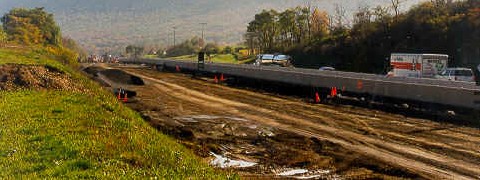
Reconstruction between mileposts 187 and
197. The $50 million
project began in Fall 1999 and concluded in Summer 2001.
(Pennsylvania Turnpike Commission)
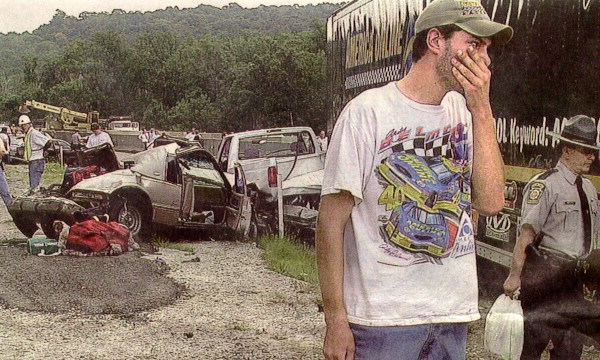
James Hunt, passenger in the truck, reacts to
the scene. (Greensburg Tribune-Review)
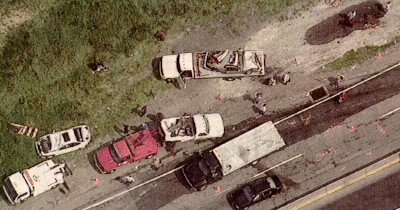
Aerial view of the accident cleanup
(Greensburg Tribune-Review)
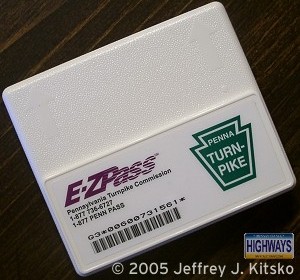 A new form of paying tolls appeared on the
Turnpike on December 2, 2000. E-ZPass, an electronic toll collection program, is used on almost all toll
bridges and highways in the Northeast. It utilizes a transponder mounted
on the windshield of your car. The transponder sends and receives
information on your car and what exit you are entering or exiting. Monthly
bills are sent to you, much like a credit card statement. It was implemented in the Harrisburg-Philadelphia areas at Exits
242 to 359 on the
main line and Exits 20 to 56 on the Northeast Extension on December 2, 2000. The next extension of E-ZPass occurred on May 19, 2001, when the
system was extended to Exit 226 on the mainline and
Exit 115 on the Northeast Extension. The rest of the Turnpike from Ohio to
Carlisle became a part of the system on December 15, 2001. Commercial
vehicles were able to use it starting on December 14, 2002. A truck from
Summers Trucking of Ephrata was the first to roll through an E-ZPass lane at the
Harrisburg West Interchange at 8 AM that day. E-ZPass wouldn't come to the
Keyser Avenue and Clarks Summit Toll Plazas until November 23, 2004.
January 2005 would be the first month E-ZPass transactions accounted for half
the toll revenue.
A new form of paying tolls appeared on the
Turnpike on December 2, 2000. E-ZPass, an electronic toll collection program, is used on almost all toll
bridges and highways in the Northeast. It utilizes a transponder mounted
on the windshield of your car. The transponder sends and receives
information on your car and what exit you are entering or exiting. Monthly
bills are sent to you, much like a credit card statement. It was implemented in the Harrisburg-Philadelphia areas at Exits
242 to 359 on the
main line and Exits 20 to 56 on the Northeast Extension on December 2, 2000. The next extension of E-ZPass occurred on May 19, 2001, when the
system was extended to Exit 226 on the mainline and
Exit 115 on the Northeast Extension. The rest of the Turnpike from Ohio to
Carlisle became a part of the system on December 15, 2001. Commercial
vehicles were able to use it starting on December 14, 2002. A truck from
Summers Trucking of Ephrata was the first to roll through an E-ZPass lane at the
Harrisburg West Interchange at 8 AM that day. E-ZPass wouldn't come to the
Keyser Avenue and Clarks Summit Toll Plazas until November 23, 2004.
January 2005 would be the first month E-ZPass transactions accounted for half
the toll revenue.
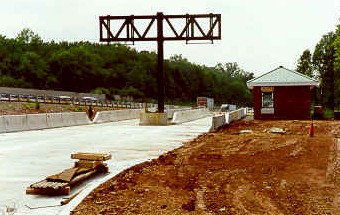
The new Virginia Drive/E-ZPass only exit.
(Pennsylvania Turnpike Commission)
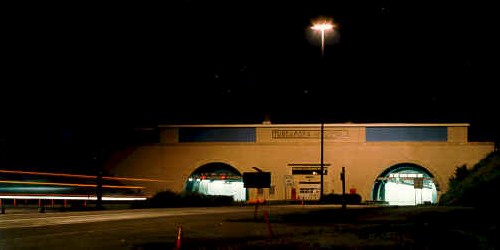
The Tuscarora Mountain Tunnel (Pennsylvania Turnpike Commission)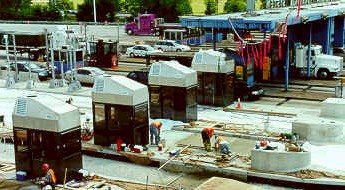
Expansion work going on at the Valley Forge exit.
(Pennsylvania Turnpike Commission)
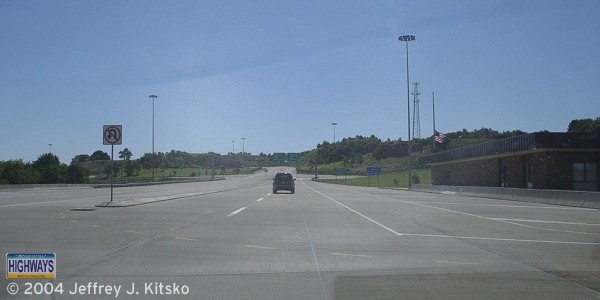
The former New Castle Toll Plaza at PA Turnpike 60. The toll booths and
E-ZPass
equipment were removed, but the building still stands.
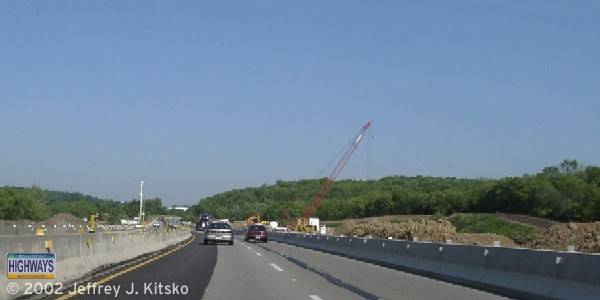
Construction in the Warrendale Toll Plaza project site on June 8, 2002.
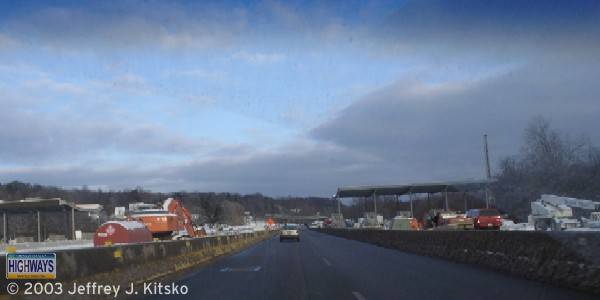
Construction in the Warrendale Toll Plaza project site on March 6, 2003.
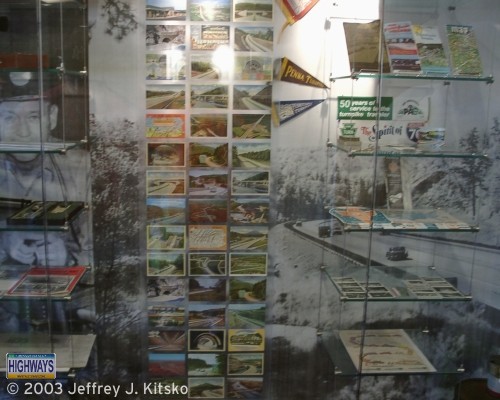
One of the displays in the lobby of the PTC headquarters building.
In front
are postcards with a Turnpike theme, and bumper stickers and maps on
the right.
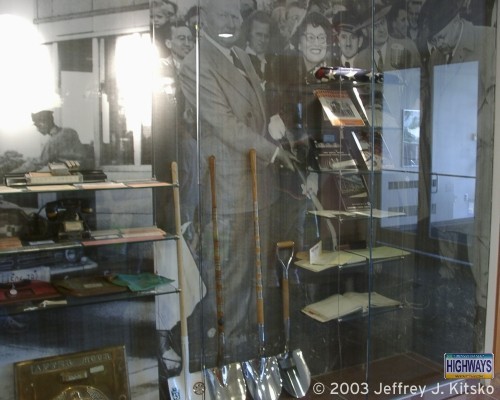
More items of historical importance featured in the lobby. Here
you can
see some of the ceremonial shovels used at groundbreaking festivities
around Pennsylvania.
Project
Cost
(in millions)
Beginning
Southeastern PA
(Philadelphia)
Six-lane widening (Exit 326 - Exit
333)
$130
10/14/2004
Six-lane widening (Exit 312 - Exit
326)
$160
2011
PA 29 Slip Ramp (E-ZPass only)
$45
2007
Norristown Interchange Rebuild
$12
2005
Northeastern PA
(Scranton/Allentown)
Lehigh River Bridge Replacement
Pohopoco Creek Bridge Replacement$70
Late 2008
Reconstruction/Widening (Exit 20 -
Exit 31)
$160
2008
Miscellaneous Regional Improvements
TBA
TBA
Central PA (Harrisburg)
Susquehanna River Bridge Replacement
(preliminary
rendering)$130
2005
Lebanon-Lancaster Interchange
Reconstruction
Gettysburg Interchange Reconstruction
(preliminary
rendering)$12
$18Spring 2005
Reconstruction (Milepost 199 - Milepost 226)
$280
2007
Western PA (Pittsburgh)
Allegheny River Bridge Replacement
$125
2007
Reconstruction
Milepost 0 - Milepost 10
Milepost 31 - Milepost 40
Milepost 40 - Milepost 48
Milepost 57 - Milepost 67
Milepost 67 - Milepost 75
Milepost 129 - Milepost 138
$100
$130
$97
$107
$92
$912007
2006
2011
2012
2006
2012
Allegheny Tunnel
Bypass/Replacement
$140 - bypass
$280 - tunnelTBA
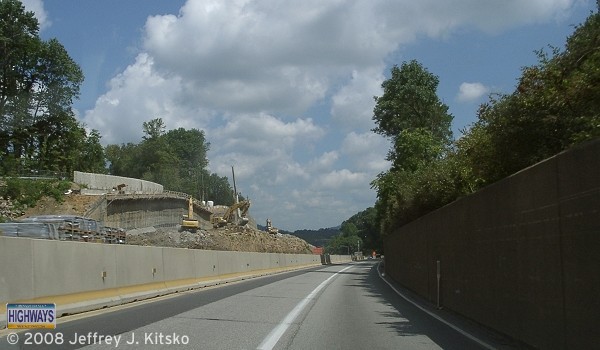
Construction taking place on the eastern shore to align the Turnpike with the
new bridge.
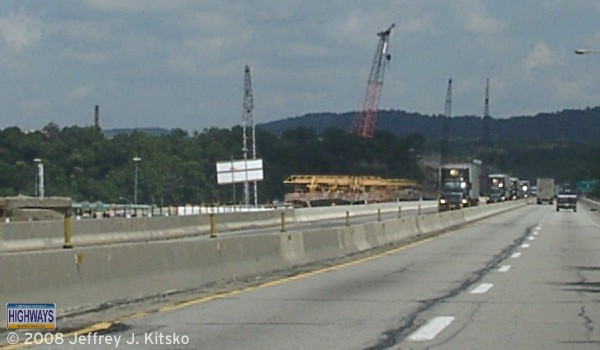
Pre-cast segments for the new bridge being placed.![]() to CEO Joseph Brimmeier, he voiced concern that this showed a lack of transparency and made it appear as if the PTC was
trying to hide the hike in tolls. Also it could potentially create a public safety hazard
from motorists wanting to have the correct amount before reaching the toll booth
using the Internet to determine their toll. Officials took exception over
Wagner's assertions, but yet decided on December 21, 2010 to reinstate printing the fare schedule on
tickets. The new tickets made it into circulation by March after the ones
without fare schedules were used.
to CEO Joseph Brimmeier, he voiced concern that this showed a lack of transparency and made it appear as if the PTC was
trying to hide the hike in tolls. Also it could potentially create a public safety hazard
from motorists wanting to have the correct amount before reaching the toll booth
using the Internet to determine their toll. Officials took exception over
Wagner's assertions, but yet decided on December 21, 2010 to reinstate printing the fare schedule on
tickets. The new tickets made it into circulation by March after the ones
without fare schedules were used.
Pennsylvania Turnpike Truck Information |
||||||||||||||||||||||
|
Minimum speed: 40 MPH (weather permitting)
IMPORTANT TELEPHONE NUMBERS
EMERGENCY CELLULAR Anyone traveling the Turnpike with a cellular telephone can dial *11 (star one one) to report accidents or incidents or request emergency aid. Calls are free and go directly to the Turnpike's operation center in Harrisburg. Turnpike radio operators and Pennsylvania State Police are on duty 24 hours-a-day, every day. If you need to call the operations center, be prepared to provide your name, location (look for a milepost marker), cellular telephone number, and the nature of your emergency. Remain on the telephone until the radio operator instructs you to hang up. EMERGENCY HELP INFORMATION Emergency call boxes are located on both sides of the Turnpike System every mile. PERMIT RESTRICTIONS Special permits are required for all loads/vehicles in excess of maximum allowance shown below:
NOTE: Vehicles between 8 feet - 6 inches and 10 feet wide do not require a permit, but must follow time-of-day travel restrictions. Over dimensional permits may be obtained by calling 717-939-9551 Extension 2980 then 2 on the phone tree. TUNNEL RESTRICTIONS PLACARDS
PROHIBITED PLACARDS
PERMITTED IN NON-BULK PACKAGING*
|
Links:
Exit Guide
Pennsylvania Turnpike Pictures
Pennsylvania Turnpike's Abandoned Sections
Pennsylvania Turnpike Reconstruction
E-ZPass and PA Turnpike TOLL BY PLATE - Pennsylvania Turnpike Commission
511PA
Pennsylvania Turnpike Commission
Pennsylvania Turnpike Toll/Mileage Calculator - Pennsylvania Turnpike Commission
Delaware
River-Turnpike Toll Bridge - Steve Anderson
History
and Pictures of the Pennsylvania Turnpike and Tunnels - Jamie Orr
Interstate 76
- Andy Field/Alex Nitzman
Lehigh Tunnel
- Alex Nitzman
The PA
Turnpike @ Pennsylvania Road Photos - Adam Prince
The
Pennsylvania Turnpike - Phil Patton
Pennsylvania
Turnpike-Allegheny River Bridge - Bruce Cridlebaugh
Pennsylvania
Turnpike-Delaware River Extension - Steve Anderson
Pennsylvania Turnpike-Northeast Extension - Steve Anderson
 INFORMATION
INFORMATION |
| Western Terminus: | Ohio state line in Enon Valley |
| Eastern Terminus: | New Jersey state line at the Delaware River Bridge in Bristol |
| Length: | 360.30 miles |
| National Highway System: | Entire length |
| Name: | Pennsylvania Turnpike |
| SR Designations: | 7076: Ohio state line to Exit 326 7276: Exit 326 to I-295 7095: I-295 to the New Jersey state line |
| Counties: | Lawrence, Beaver, Butler, Allegheny, Westmoreland, Somerset, Bedford, Fulton, Huntingdon, Franklin, Cumberland, York, Dauphin, Lebanon, Lancaster, Berks, Chester, Montgomery, and Bucks |
| Multiplexed Routes: | I-70: Exit 75 to Exit
161 I-76: Ohio state line to Exit 326 I-276: Exit 326 to I-295 I-95: I-295 to the New Jersey state line |
| Former Designations: | I-80 (1957 - 1958):
Ohio state state line to Exit 226 I-80S (1958 - 1958): Ohio state line to the New Jersey state line I-80S (1958 - 1963): Ohio state line to Exit 326 I-80S (1963 - 1973): Ohio state line to Exit 57 I-280 (1958 - 1963): Valley Forge to the New Jersey state line I-276 (1963 - 2018): I-295 to the New Jersey state line |
| Former LR Designations: | None |
| Emergency: | *11 |
 Washington's Trail: |
Exit 67 to Exit 75 |
 Highway Conditions: |
https://www.paturnpike.com/webmap/PTCIE-2.aspx 1-866-976-TRIP |
 Traffic Cameras: |
Gateway
(Eastbound) Gateway (Westbound) Warrendale (Westbound) Warrendale (Westbound) Pittsburgh (Westbound) Pittsburgh (Eastbound) New Stanton (Westbound) Breezewood (Westbound) Breezewood (Eastbound) Susquehanna River Bridge (Eastbound) Susquehanna River Bridge (Westbound) Harrisburg East (Westbound) Valley Forge (Westbound) Plymouth Meeting (Westbound) Fort Washington (Westbound) Willow Grove (Westbound) Bensalem (Westbound) |
| Advisory Radio: | 1640 |
 INFORMATION - Northeast Extension
INFORMATION - Northeast Extension |
| Southern Terminus: | I-276 at Exit 20 in Norristown |
| Northern Terminus: | US 6/US 11 in Clarks Summit |
| Length: | 111.30 miles |
| National Highway System: | Entire length |
| Name: | Pennsylvania Turnpike Northeast Extension |
| SR Designation: | 7476 |
| Counties: | Montgomery, Bucks, Lehigh, Carbon, Luzerne, and Lackawanna |
| Multiplexed Route: | I-476: Entire length |
| Former Designation: | PA 9 (1974 - 1996) |
| Former LR Designations: | None |
| Emergency: | *11 |
 Highway Conditions: |
https://www.paturnpike.com/webmap/PTCIE-2.aspx 1-866-976-TRIP |
| Advisory Radio: | 1640 |